2023 Q4 and Full Year results webcast and presentation
Download the podcast (MP3 34 MB)
Download the presentation (PDF 5.5 MB)
Transcript
View the 2023 Q4 and Full Year results presentation and read the transcript slide by slide
Download the podcast (MP3 34 MB)
Download the presentation (PDF 5.5 MB)
View the 2023 Q4 and Full Year results presentation and read the transcript slide by slide
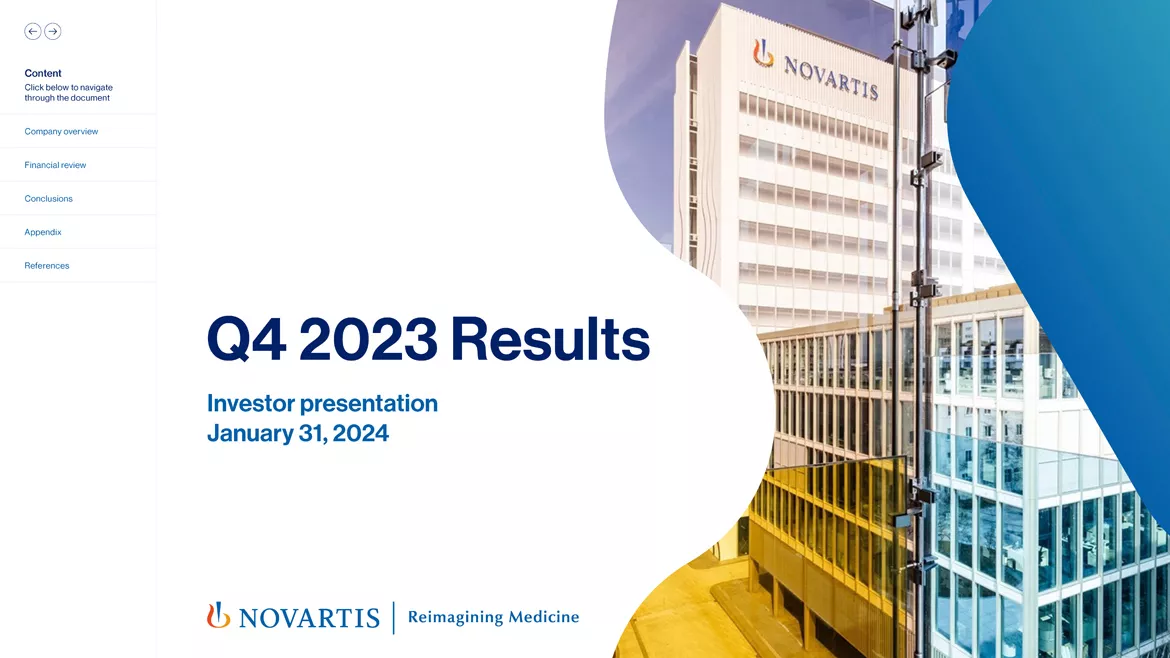
Thank you very much, and good morning and good afternoon, everybody. Thank you again for listening to our full year results and Q4 results.
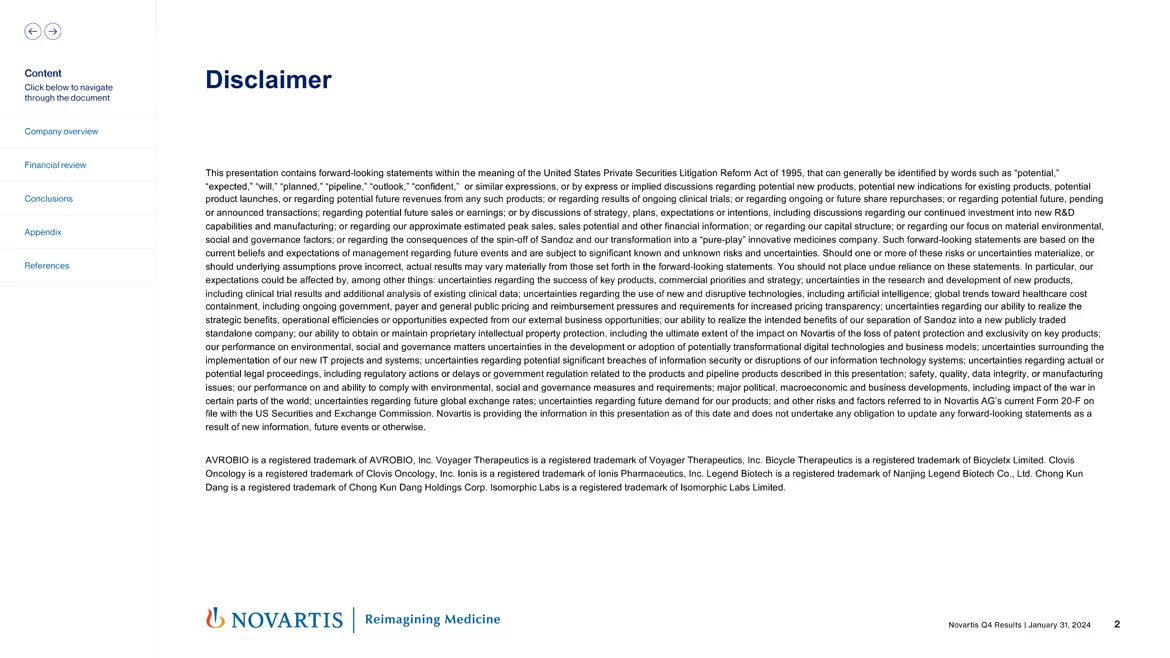
The information presented today contains forward-looking statements that involve known and unknown risks, uncertainties and other factors. These may cause the actual results to be materially different from any future results, performance or achievements expressed or implied by such statements.
For a description of some of these factors, please refer to the company's Form 20-F and its most recent quarterly results on Form 6-K that, respectively, were filed with and furnished to the US Securities and Exchange Commission. And with that, I'll hand the call to Vas.
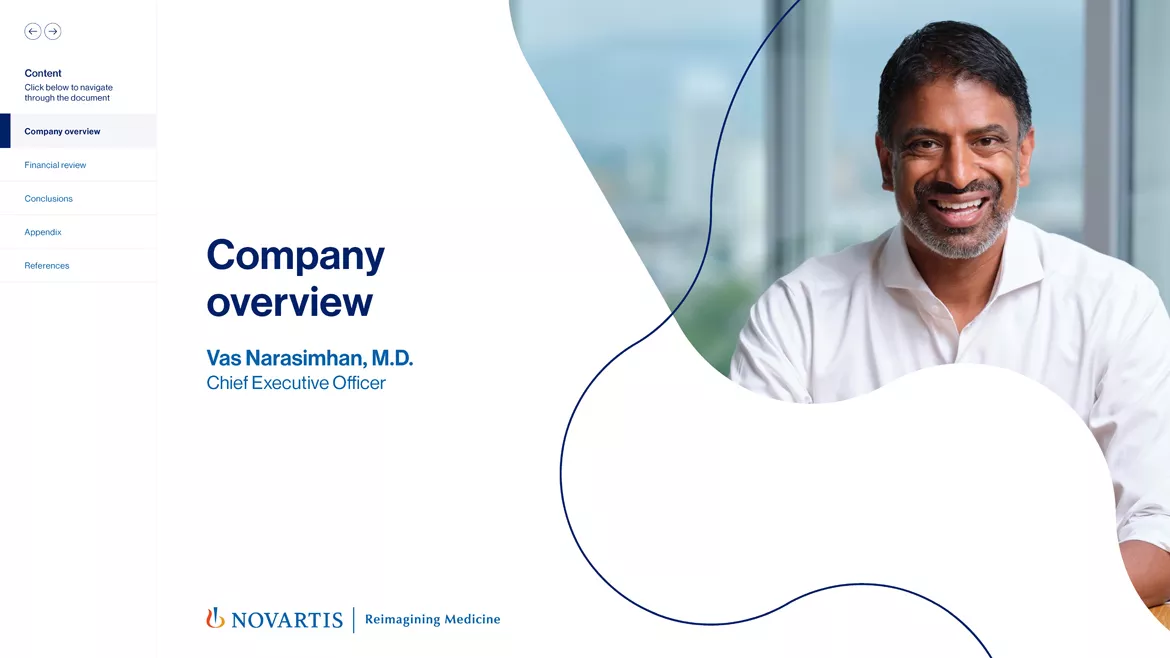
Thank you, Samir, and thanks, everyone, for joining today's call. I know it's a busy day with many companies reading out, but we hope to provide you some insights into our Q4 2023 results and also some perspectives on the outlook for Novartis in 2024 and beyond.
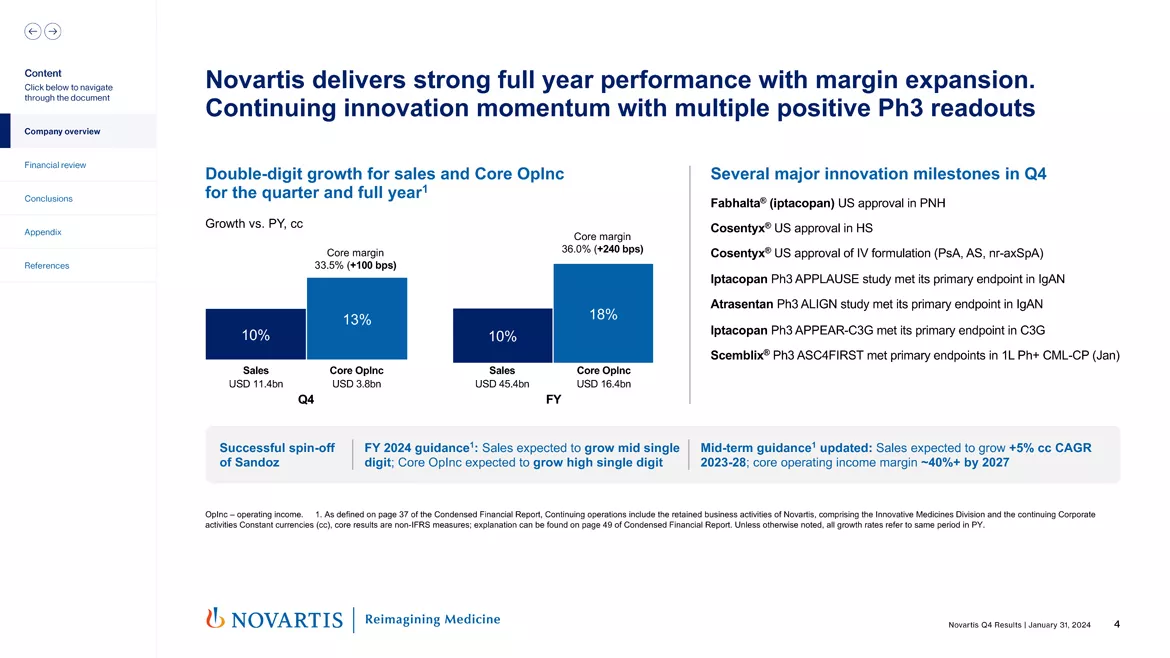
If we move to the first slide, Slide 4, as you saw in our earnings release this morning, we delivered a strong full year performance with margin expansion and strong innovation momentum with 10 positive Phase III readouts over the course of 2023. As a reminder, our full year guidance at the start of the year was quite a bit lower than where we ended up. And we had multiple earnings upgrades over the course of the year, demonstrating, I think, the strong business momentum we have at the company.
Q4 sales up 10%, core operating income was up 13%. And on the full year, we were up 10% on sales and core operating income up 18%, all in constant currency, and Harry will go through this in more detail in a few moments.
We also had the successful spin-off of Sandoz as a really value-creating event for Novartis and our shareholders. We provided our updated 2024 guidance, where we expect to grow mid-single digit and Core OpInc expected to grow high single digit, and we've chosen to be prudent with this guidance at this point in time.
And then looking to our midterm guidance, which I'll also go through in more detail, we've extended our midterm guidance of 5% constant currency CAGR growth through 2023 to 2028 and continue to hold to our core operating income margin guidance of 40% plus by 2027.
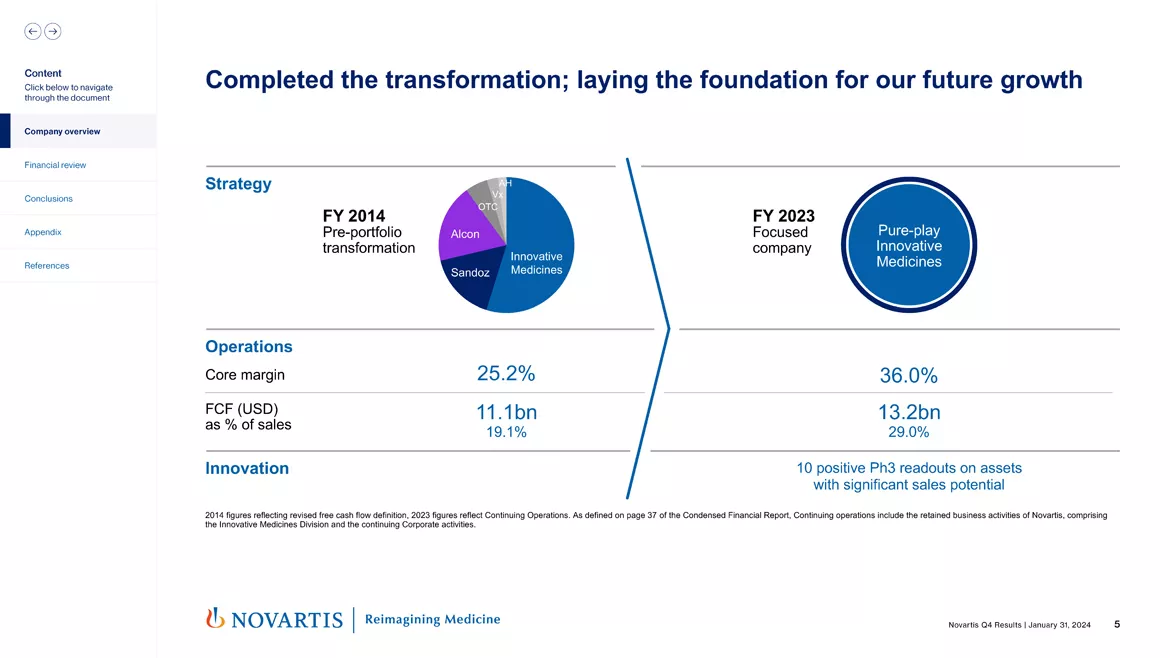
So moving to Slide 5. This year was a really critical year for the company because we completed the transformation of Novartis, and we believe really laying a strong foundation for our future growth. Since 2014, we have spun off both Alcon and Sandoz in shareholder-friendly ways. We have exited our OTC stake also in a shareholder-friendly approach in creating a new OTC company with GSK and also importantly, exited our Roche stake, completing a USD 15 billion share buyback and then continuing USD 15 billion share buyback, which is ongoing currently, and we expect to complete by mid-2025.
That leaves us as a pure-play innovative medicines company with a margin of 36% on its way to the 40% plus, strong free cash flow and a strong innovation engine, which we think positions us well for the long run.
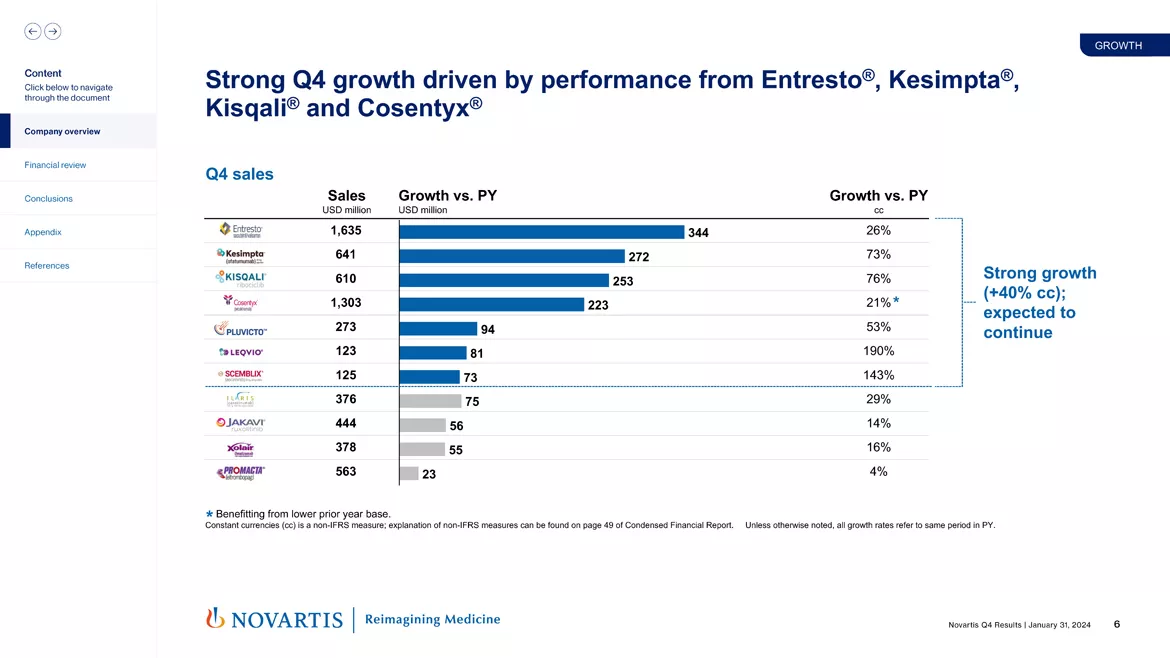
So moving to Slide 6. When you look at Q4, most importantly with the underlying growth of our key growth drivers, which grew 40% overall on the quarter, and that growth rate, we expect to continue. That underlying growth is what gives us confidence that we can grow mid-single digit in the coming years and then continue that growth in 2028 and beyond in the mid-single-digit plus range. A combination of these growth drivers as well as strong pipeline productivity puts us, I think, in a strong position to be a consistent grower over the next decade.
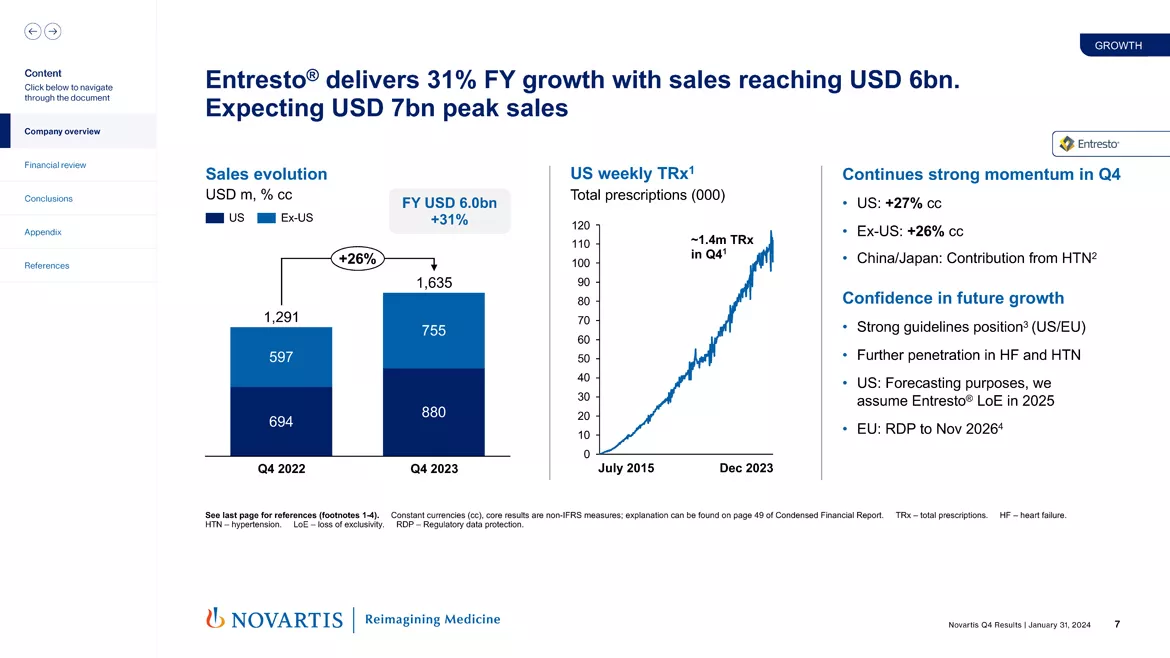
And moving to Slide 7. And I want to just walk through each of the brands to give you some perspectives and then look forward to taking your questions. So first, Entresto delivered 31% growth with sales reaching USD 6 billion, and we're well on track to reach our peak sales goal of USD 7 billion plus. This growth was both in the US and ex-US geographies. You can see on our weekly TRx, we continue to reach record highs. We had constant currency growth of 27% and 26% in US and ex-US and China and Japan contributed strongly with strong performance with our ongoing hypertension launches.
So looking forward, we expect continued growth for this brand. We maintain our guidance for forecasting purposes that an Entresto LOE would not occur until 2025. And we also maintain our guidance on EU regulatory data protection to November 2026.

So moving to Slide 8. Now, Cosentyx® reached USD 5 billion in 2023. And we expect to see at least mid- to high single-digit growth in 2024 on our way to our guidance of USD 7 billion peak sales. Going a little deeper into this performance, we saw a 17% growth in the US and 26% outside the US. This was in part in the US due to revenue deduction adjustments we had in the prior year leading to a lower base.
But we are seeing very good momentum on our IV and hidradenitis launches in the US and in hidradenitis in Europe, which gives us confidence that Cosentyx® can be a dynamic grower over the coming years. We'll continue to keep you updated on how these launches progress over the coming quarters. And then we also will keep you updated as well on the 3 ongoing Phase III studies we are progressing in giant cell arteritis, PMR and rotator cuff tendinopathy.
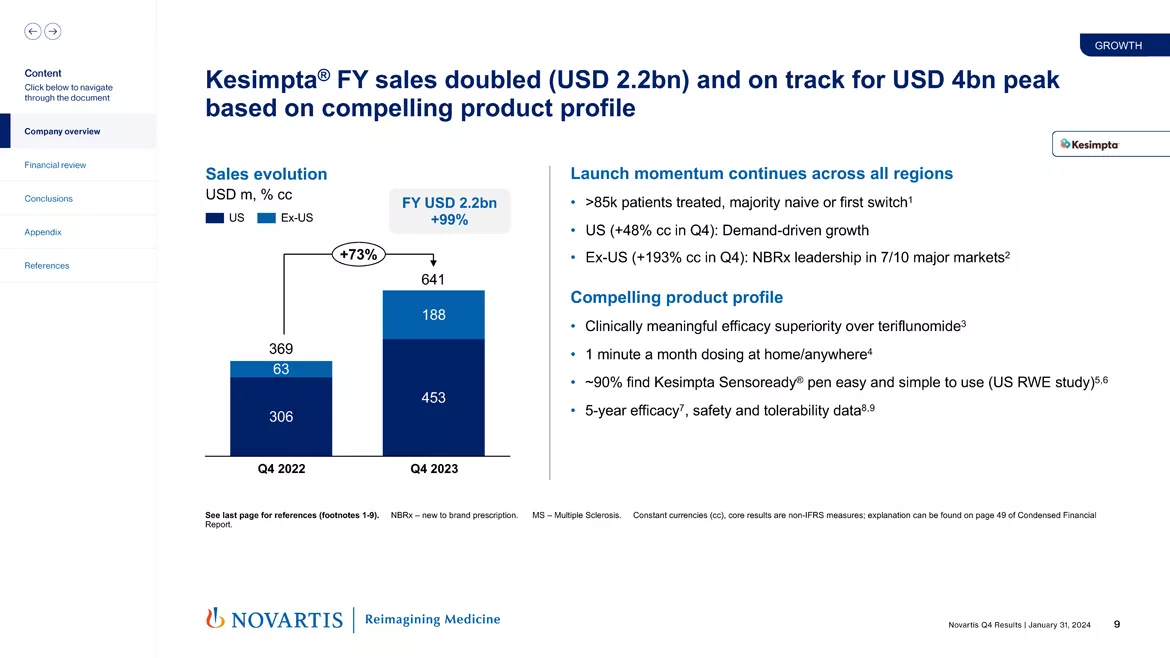
So moving to Slide 9. Kesimpta® sales in the full year doubled to USD 2.2 billion. We remain on track to reach our USD 4 billion peak sales guidance, strong growth in the US, but also now increasing growth in Europe and in the ex-US market. We currently see 85,000 patients treated with Kesimpta® today. Our US growth is 48% in constant currencies, ex US at 193%. And we have NBRx leadership now in 7 out of 10 major markets outside of the United States.
I think everyone knows well the compelling profile we have in terms of efficacy and convenience as well as the easy-to-use Sensoready pen that patients can benefit from with Kesimpta®. We have 5 years of efficacy, safety and tolerability, and we'll look forward to continuing to expand this brand, both in terms of the growth of the B-cell class in MS, but also increasing our NBRx share within the B-cell class as a key growth driver.
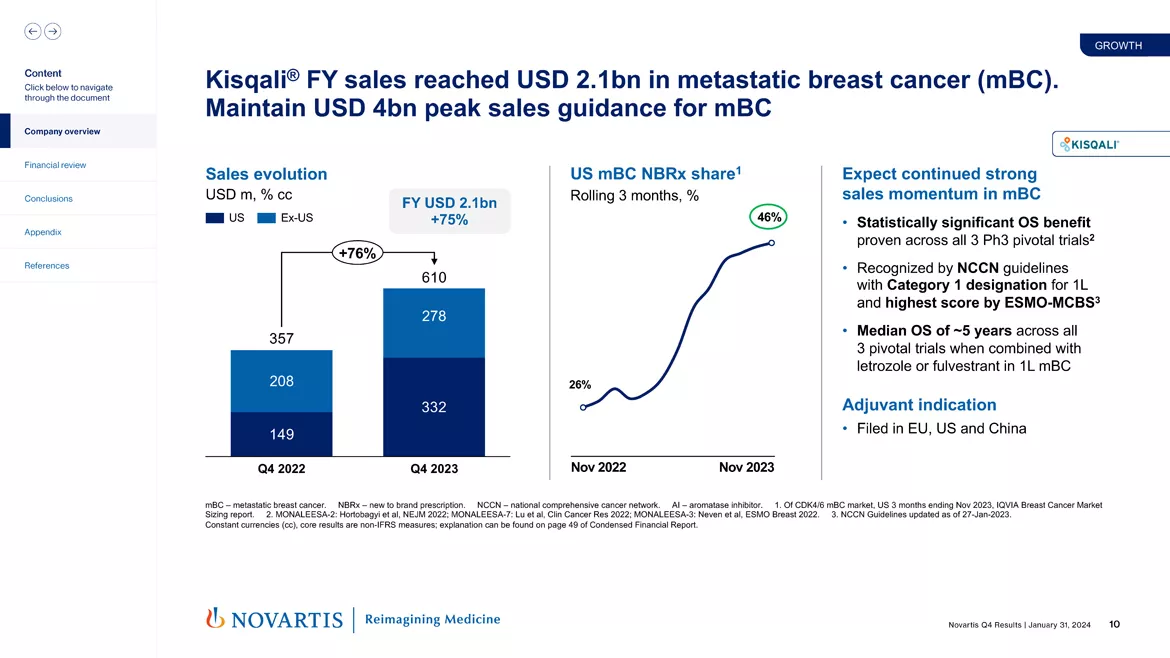
Moving to Slide 10. Now Kisqali® reached USD 2.1 billion in the metastatic breast cancer setting. We maintained our USD 4 billion peak sales guidance in the metastatic breast cancer setting alone. You can see this growth again was driven by both the US and our international business. Our rolling NBRx share in the metastatic setting is now up to 46%, and we see continued strong growth in the metastatic setting.
This is driven by the statistically significant OS. We have now across 3 pivotal studies, the NCCN Category 1 designation, and the median OS of 5 years we've demonstrated across those 3 pivotal trials. We can confirm that we have filed in the EU, US and China, the adjuvant indication across intermediate and high-risk breast cancer, and we'll look forward to keeping you up to speed as we progress towards hopefully, those approvals and launches over the course of this year.
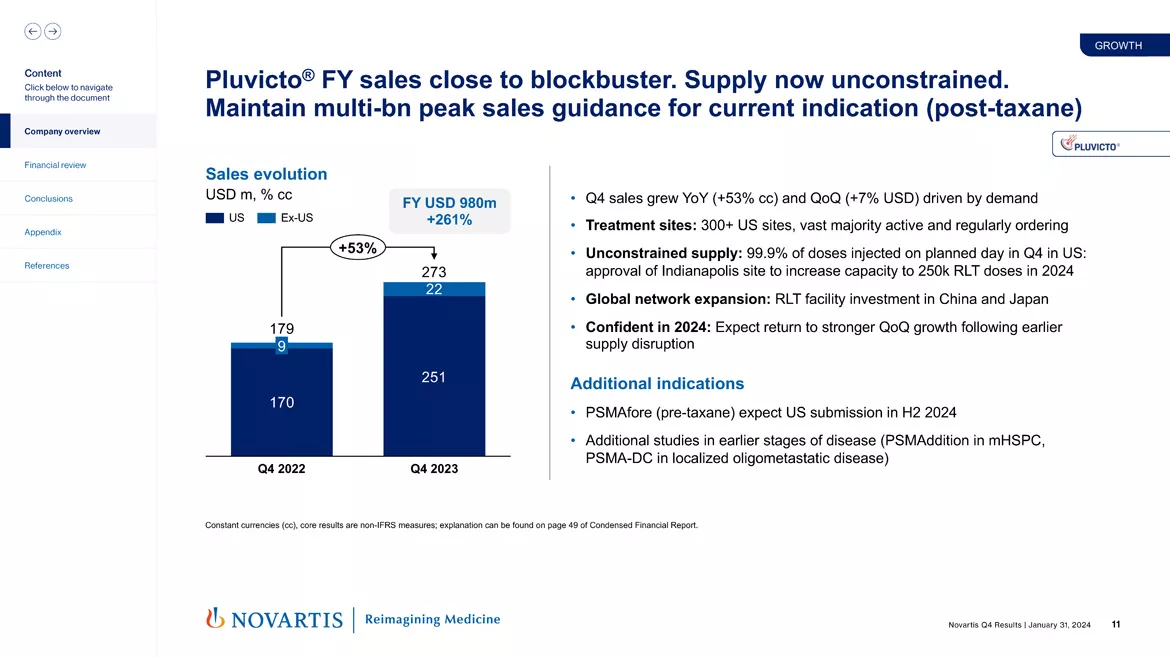
Now moving to Slide 11. Pluvicto®, our full year sales closed out a near blockbuster status at USD 980 million. Importantly now, we see unconstrained supply for this brand. We maintain our multibillion-dollar peak sales guidance for the current indication. And I can say we see very strong demand signals and growth dynamics in January, consistent with our expectations. But as we clear the supply constraints and some of the challenges we saw in quarter 4, we would get back to strong robust growth in quarter 1, 2024, and what we would expect is robust quarter-on-quarter growth over the course of this year.
Some more details in terms of treatment sites. We have over 300 US sites now that are active and regularly ordering, fully unconstrained supply, we're 99.9% now doses injected on planned day with a capacity of 250,000 radioligand therapy doses expected in 2024 with the approval now of our Indianapolis site. We have a network expansion ongoing to prepare for launches in Asia with announced investments in both China and Japan. And as I already noted, we expect robust quarter-on-quarter growth over the course of 2024.
Our PSMAfore expected US submission is second half 2024, and we'll keep you updated as we progress towards that. And we also remain on track on both our PSMAddition and PSMA localized oligometastatic disease trials to move Pluvicto® into earlier lines of therapy.
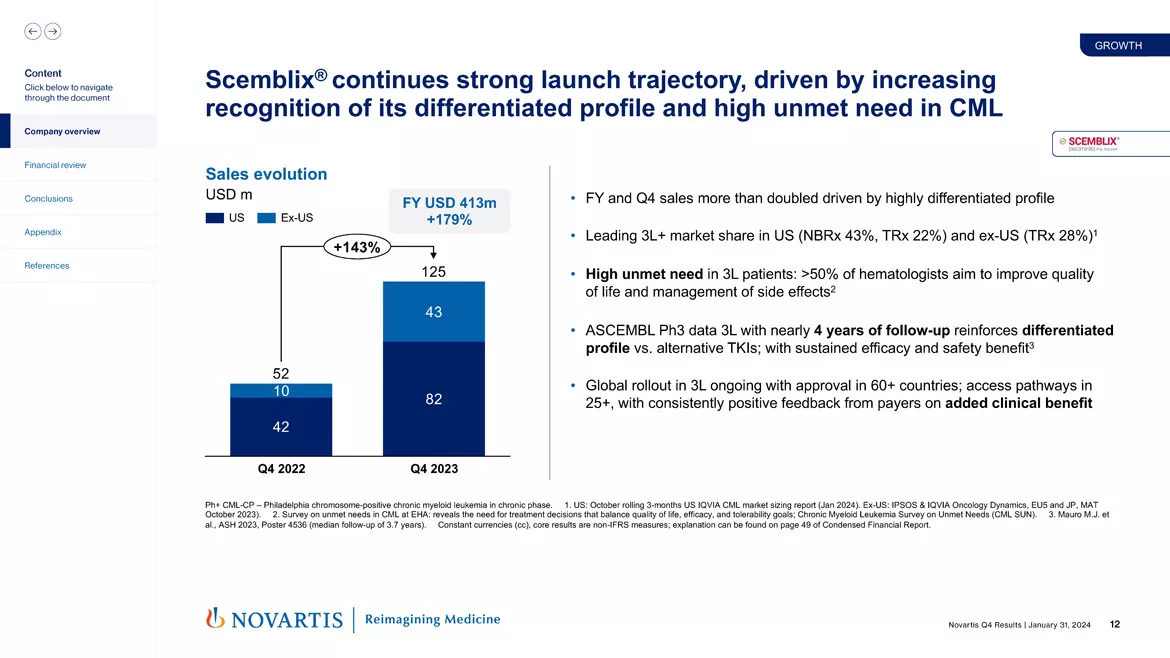
Now moving to Slide 12. Scemblix® had a strong year and strong quarter, moving up now to USD 125 million in quarter 4, 2023. This is in the third line setting where we have leading third line market share, NBRx share of 43%, TRx share of 22%. I think as you all well know, there's high unmet need in the third line setting and over 50% of hematologists really want improvements in quality of life and better management of side effects, and Scemblix® really delivers that.
Now we have 4 years of follow-up that really demonstrated differentiated profile in terms of efficacy as well as a very clear and strong safety profile. So the global rollout in the third line setting is ongoing. We have approval in over 60 markets. We have access granted now in over 25 markets and very positive feedback from payers on the clinical benefit.
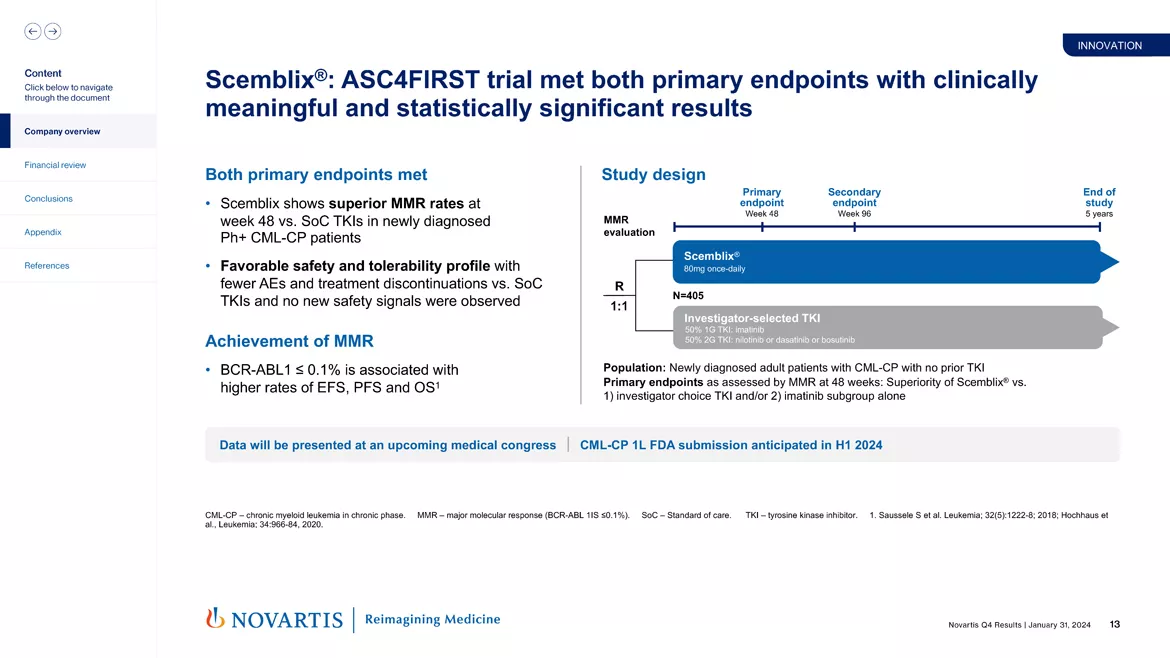
Now moving to Slide 13. We read out earlier this month, the ASC4FIRST trial, which met both its primary endpoints with clinically meaningful and statistically significant results in the frontline setting for Scemblix®. As a reminder, this study had Scemblix® compared to investigator choice TKI. We estimate 50% of the patients were on imatinib and 50% of the patients were on second-gen TKIs, nilotinib or dasatinib or bosutinib.
Both primary endpoints were met. We showed superior major molecular response rates at week 48 versus standard of care. And we also had a very favorable safety and tolerability profile with fewer AEs, treatment discontinuation and no new safety signals observed. So we're very excited about this data. Importantly, MMR is a good predictor, a reasonable predictor of important endpoints such as PFS, OS and EFS. So this data will be presented at an upcoming medical Congress. We're moving rapidly towards a submission in the first half of 2024, and we'll look forward to sharing this full data set and really providing our conviction that Scemblix® can be a multibillion-dollar medicine for Novartis.
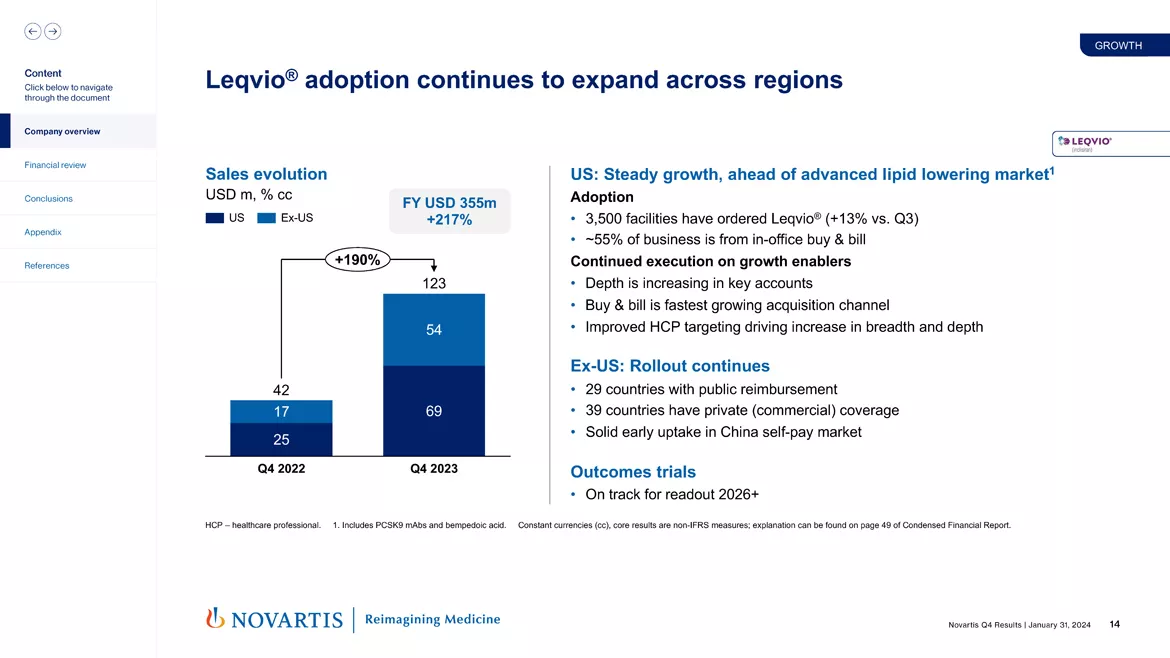
Now moving to Slide 14. Leqvio® continued its steady expansion in the US as well as across regions. You can see here, we delivered USD 123 million on the quarter growth in both our international and our US business. On the US side, we have 3,500 facilities now ordering Leqvio®, which is a 13% growth versus quarter 3. 55% of that business now is coming from in-office buy and bill. And we expect to continue to drive growth on this brand by driving depth in our key accounts as well as expanding the buy-and-bill acquisition channel.
Ex US, our rollout also continues well with 29 countries with public reimbursement, 39 countries with private coverage, and we see very positive solid early signals in China in the self-pay market which we would expect to continue over the course of 2024 ahead of a proposed NRDL listing in 2025. In terms of the outcome trials, we remain on track for our secondary prevention outcome studies in 2026, and we also continue to enroll our primary prevention studies as well.
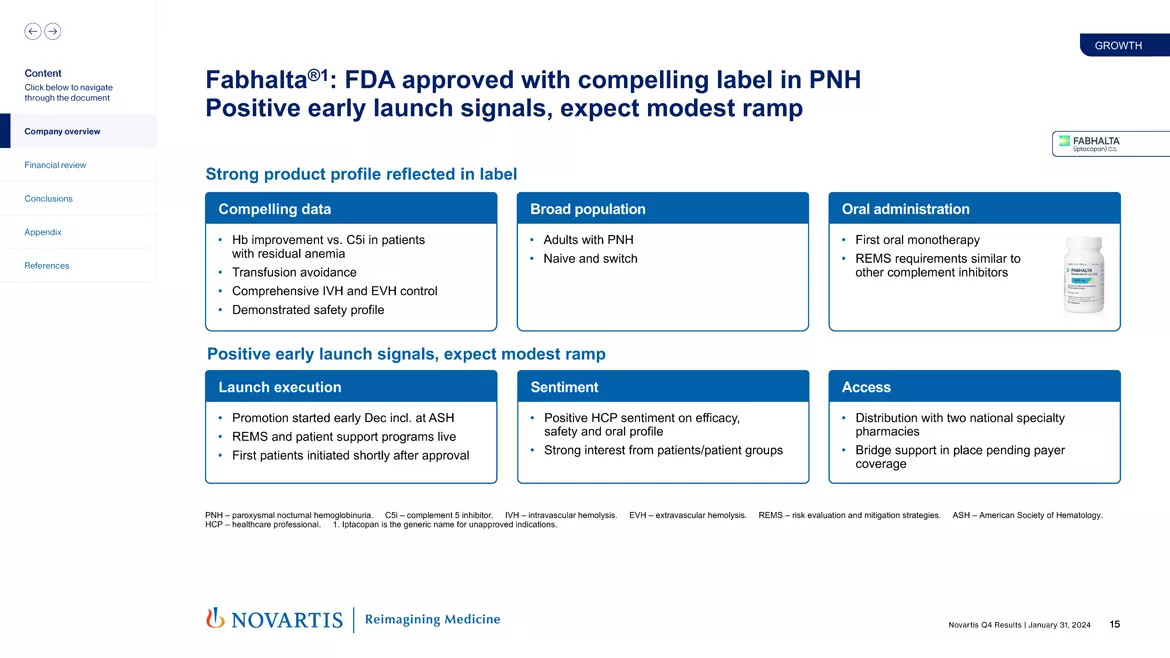
And moving to Slide 15. Fabhalta® now has launched in the United States, and we see, I think, very positive early launch signals, but we do expect a modest ramp for this brand given the dynamics within the PNH market. As a reminder, we have very compelling data for this medicine, including improvements in hemoglobin transfusion avoidance, IVH, intravascular and extravascular hemolysis control and a very clean safety profile.
Our populations in our label are both – are adults with PNH, both naive and switch patients which was our target label for this medicine. And with – as an oral therapy, we think we really provide a unique offering for patients with PNH. There is a REMS requirement, but this is similar to other complement inhibitors. Right now, as we look at our launch, our focus very much is coming out of ASH, getting patients up on our patient support program, getting our REMS up and running. Our first patients have already been initiated.
And what we're hearing is positive HCP sentiment and interest from patients and payer groups. And our goal will be initially to focus on newly diagnosed patients as well as patients who are not currently under full control for their hemolysis with their existing therapies. Over time, we would want to certainly expand this market. We estimate half of patients with PNH are currently not on therapy. And with an oral agent, we have the possibility, we hope, over time, to get more patients on therapy to avoid any of the subsequent sequela associated with PNH.
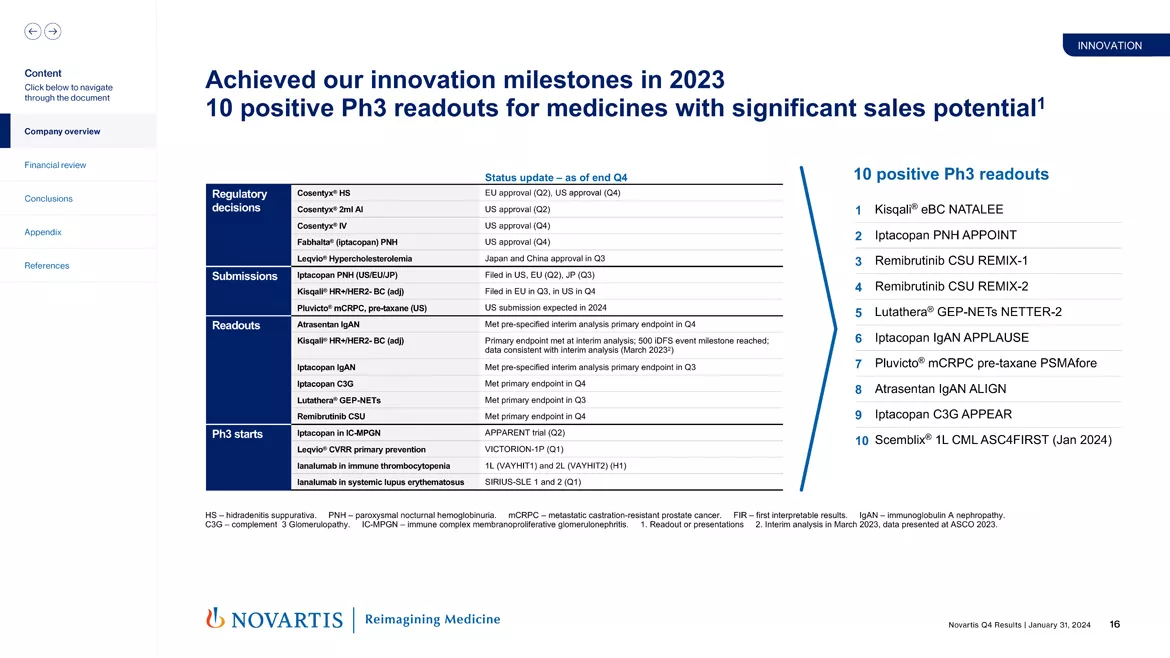
Now moving to Slide 16. As noted in 2023, we had 10 positive Phase III readouts with significant sales potential. You see them listed here. A lot of this data will be presented over the course of 2024. So you'll have a better understanding of the potential of these medicines, whether it's medicines like remibrutinib. We've already seen the Lutathera® NETTER-2 data, which I think is really outstanding. And hopefully, some of you saw that potential now for Lutathera® front line setting. Of course, the data for atrasentan and iptacopan and the Scemblix® data, which I've already mentioned.
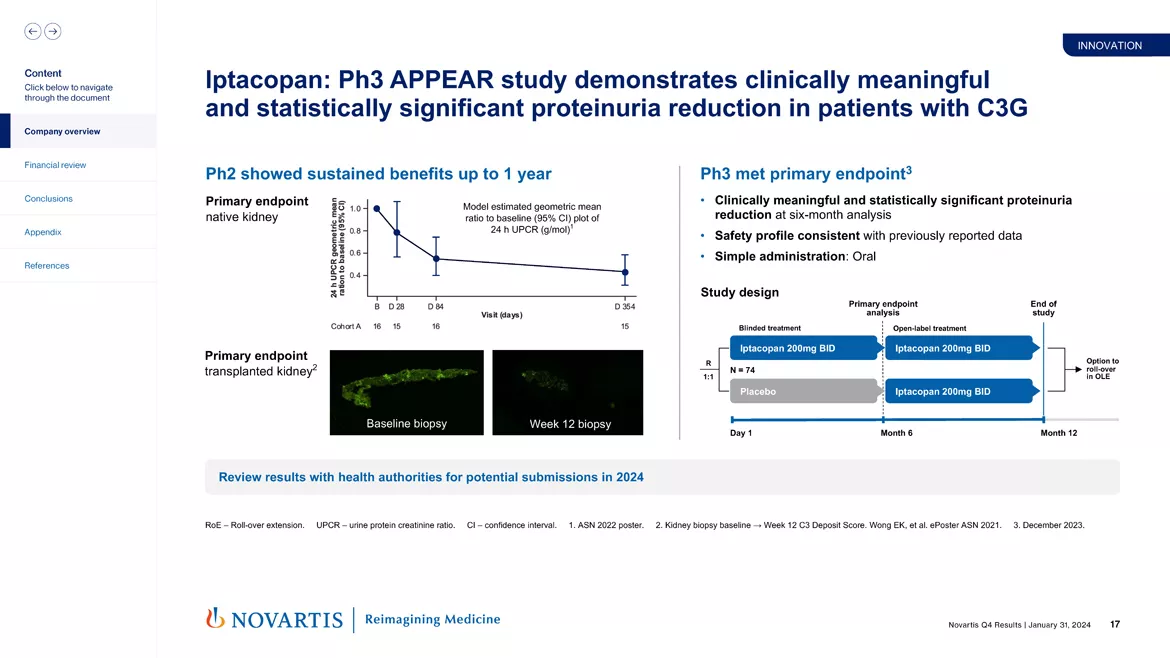
So moving to Slide 17. I just want to say a word of some of the top line readouts we had in quarter 4. Iptacopan had another – it's a third Phase III readout with a positive – a positive Phase III readout with clinically meaningful and statistically significant proteinuria reduction in patients with C3G glomerulonephropathy. You see here on the left, the Phase II data, which we previously disclosed.
In Phase III, we had a study design versus placebo, looking at month 6 before patients crossed over to Iptacopan on both arms. We saw this really important proteinuria reduction and safety profile consistent with what we've seen in previous data, and we're currently engaged with regulatory agencies with a goal for submissions in 2024.
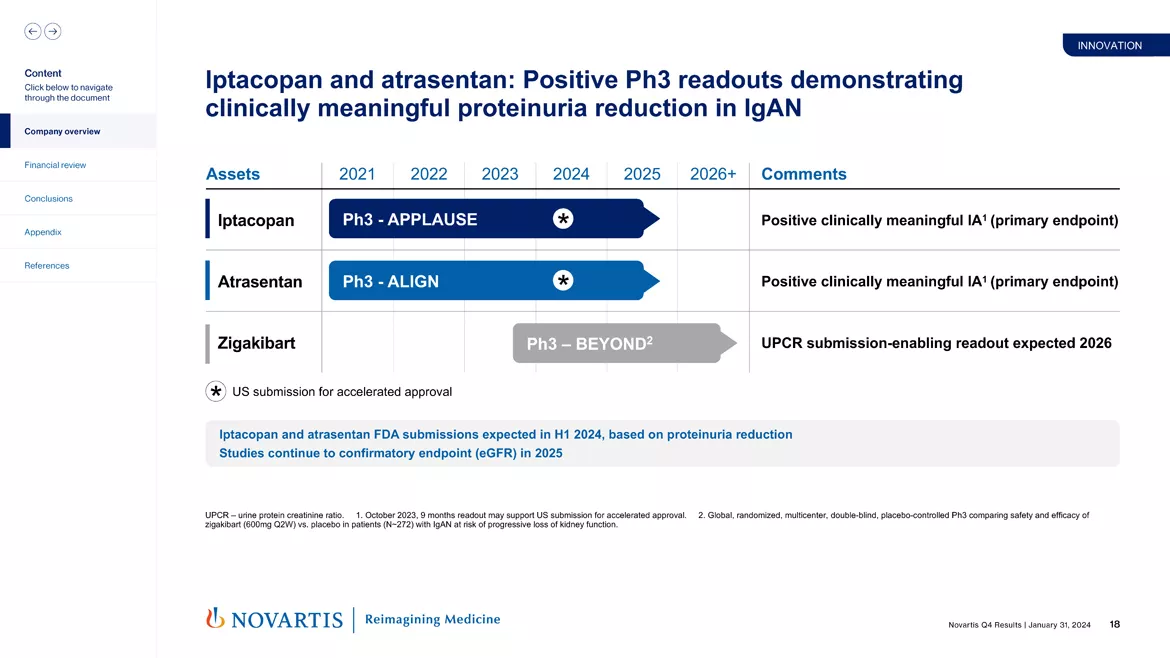
And moving to Slide 18. Over the course of the year, we had positive readouts both on iptacopan and our newly acquired atrasentan in IgA nephropathy, clinically meaningful results here as well. Both of these programs have been reviewed with the FDA and we're on track for submissions of these medicines that would really allow us to have, I think, a robust portfolio of medicines to bring to nephrologists in IgA nephropathy and then in the future C3G as we continue to try to build out a nephrology presence around the world. Zigakibart, our anti-APRIL antibody, also acquired in the Chinook acquisition, is also on track in its Phase III study.
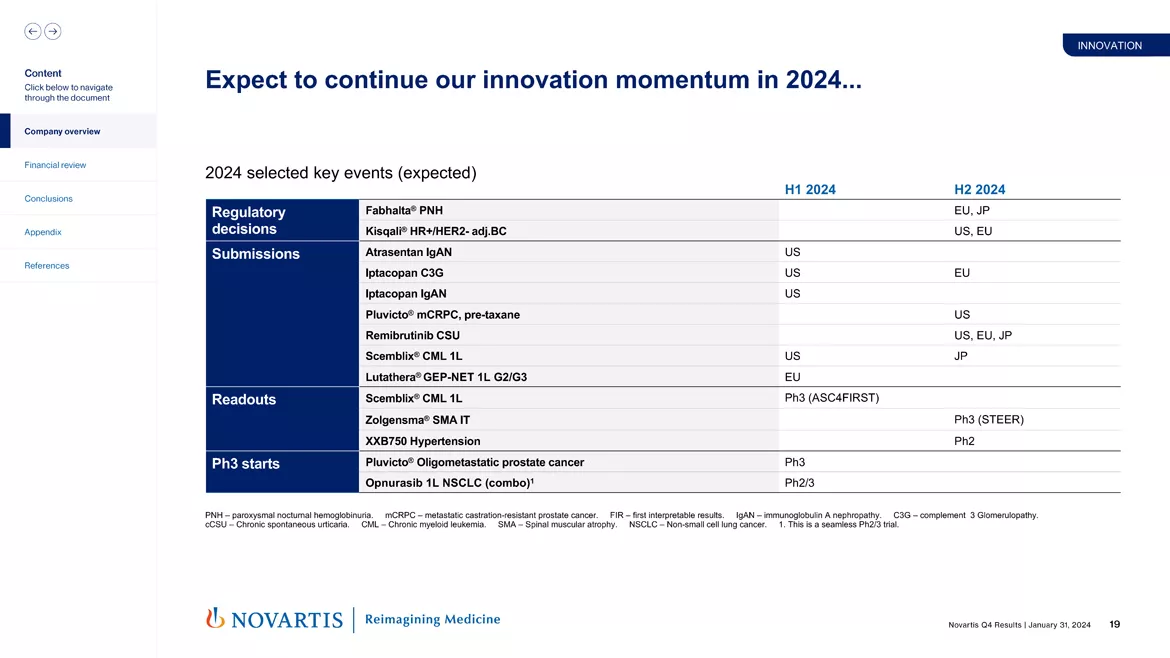
So moving to Slide 19. Now we expect our innovation momentum to continue in 2024. This will be a year of data readouts – full data readouts and submissions primarily for the company. We expect a few Phase III starts, but importantly, as I mentioned, key data readouts and submissions. We'll keep you posted on as we progress.
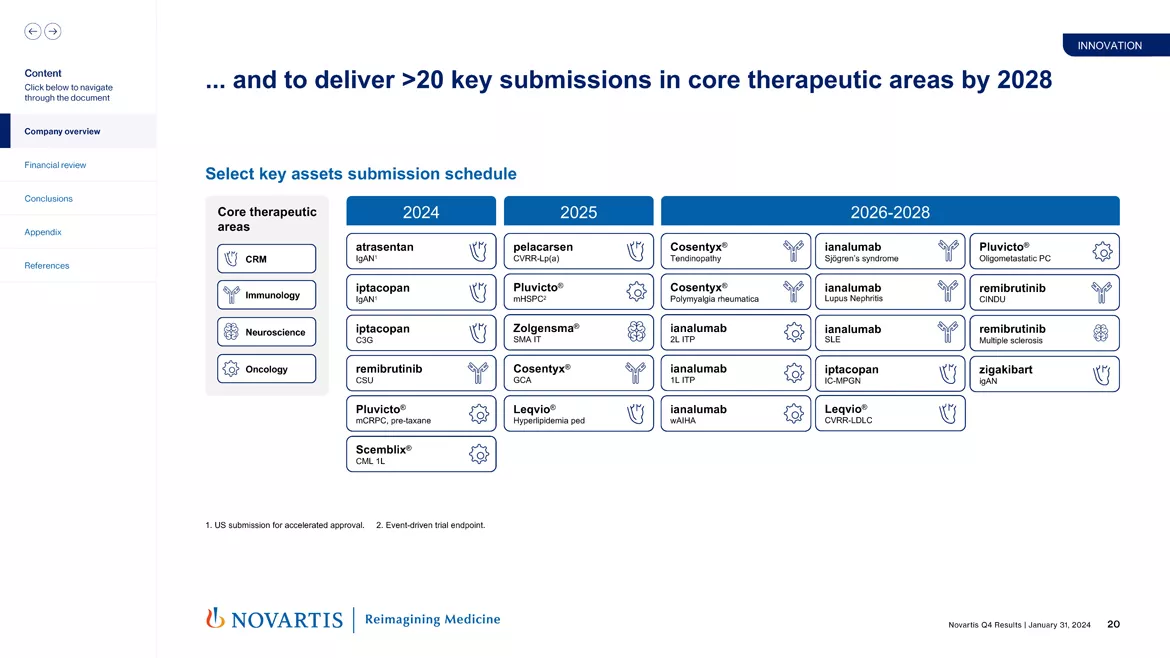
And when you look at Slide 20, this is where – why we have confidence as well that we'll have a steady stream of innovation to drive the company's growth beyond 2028. With the number of exciting, I think, assets we have, '24, '25 as well as the '26-'28 time frame. This will create a steady flow replacement power and innovation, enabling us to drive that mid-single-digit growth rate beyond.
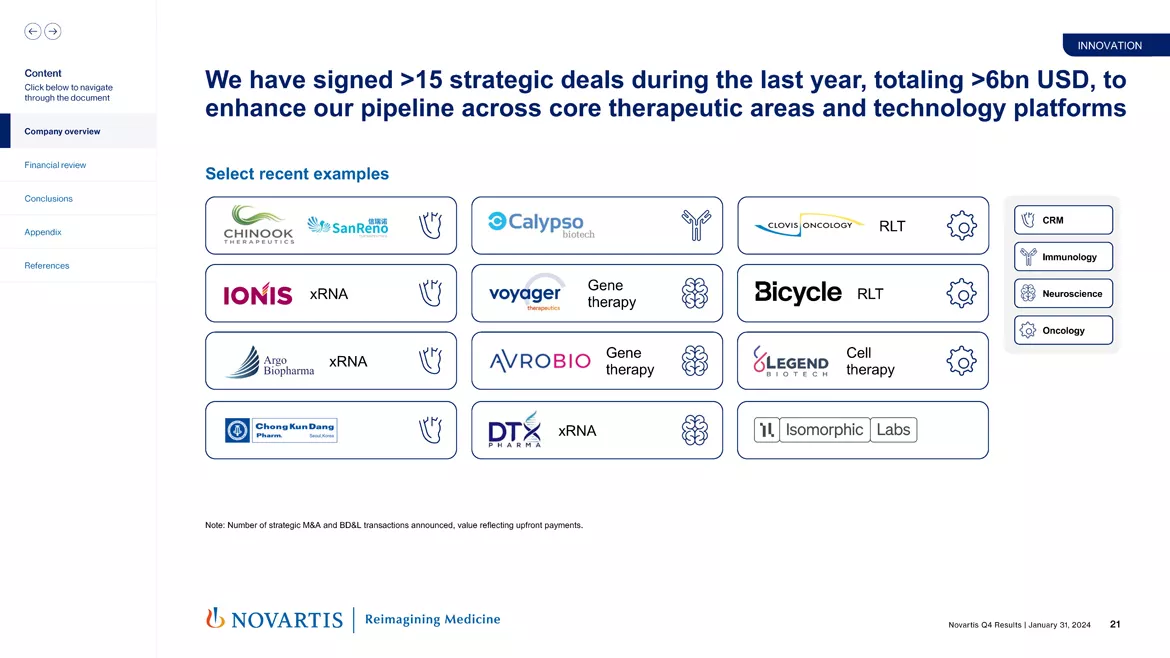
Now moving to Slide 21. Over the course of the year, we also signed 15 strategic deals as well as acquisitions totaling over USD 6 billion. I do want to emphasize our core approach in M&A remains as bolt-on acquisitions in the sub-USD 5 billion space. Deals such as Chinook, but also many smaller deals you can see across the full landscape. We're very much focused on technologies like xRNA, gene therapy and RLT as well as our key therapeutic areas like – such as Chinook amongst others.
We also continue to invest in artificial intelligence on top of our collaborations with Microsoft and Palantir. We've also signed an agreement now with Isomorphic Labs of Google's DeepMind, which really allows us, I think, to be partnered with some of the most preeminent AI researchers in the world to speed up our drug discovery and drug development.
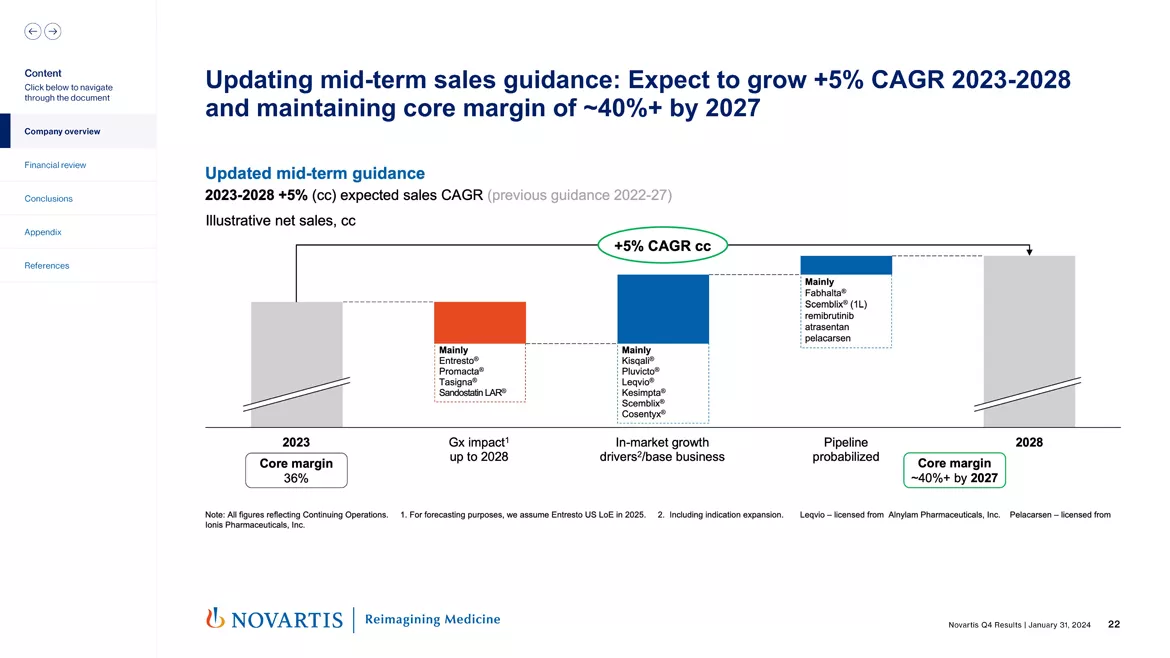
Now moving to Slide 22. We did also today extend and update our midterm guidance. You'll remember at R&D Day, we had noted '22 to '27, 5% CAGR. And today, given the momentum we're seeing on our growth drivers and the strong pipeline performance we're seeing, we're extending that 5% growth guidance to '23 to '28. Now of course, up until '28, we do have some Gx impact, which I'm sure we can discuss further in the Q&A.
But the momentum we're seeing in our in-market growth drivers across our base business across each of the brands, which I've already discussed as well as the positive data that we've seen in Fabhalta®, Scemblix®, remibrutinib and atrasentan gives us confidence now that we can continue that 5% growth up to '28, and as we've already guided mid-single digits beyond that.
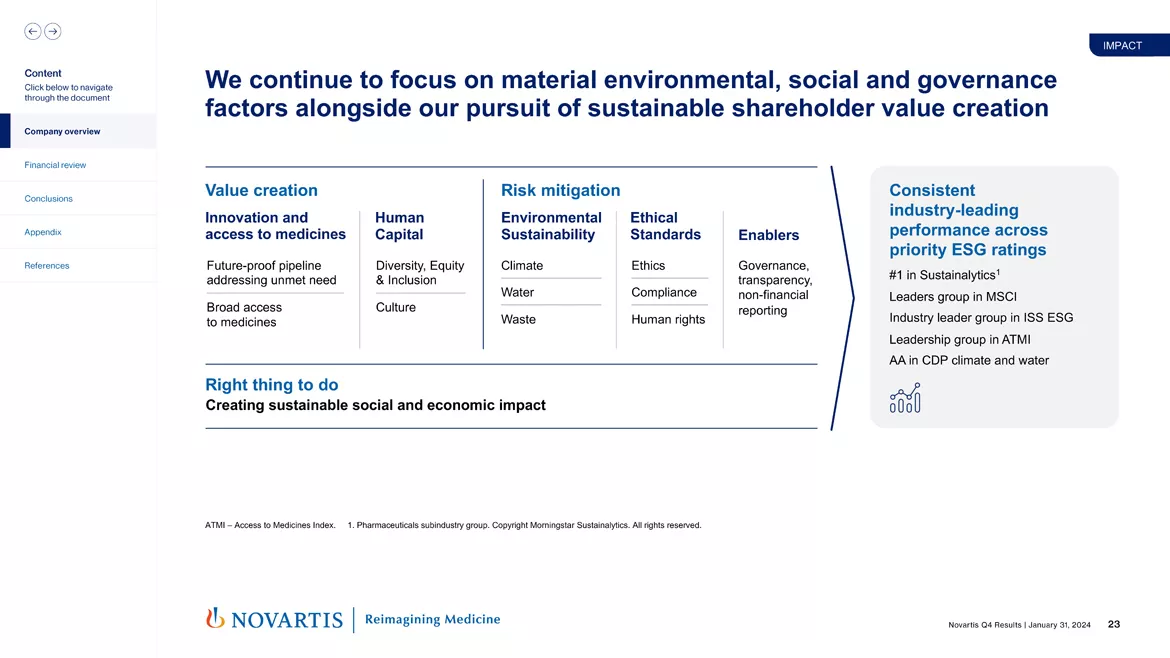
So moving to Slide 23. I want to close with just a word on ESG, which remains very much a part of the Novartis' strategy and Novartis' approach. We focus on innovation and access to medicines, human capital in terms of our work on DE&I culture as well as ensuring that we're amongst the leaders in environmental sustainability and ethical standards.
When you look at our performance, now we're #1 in Sustainalytics in the Leaders Group in MSCI and also amongst the leaders in important other benchmarks such as access to medicine and CDP, and we plan to continue that, of course in 2024. And so with that, on Slide 24, I'll hand it over to Harry.
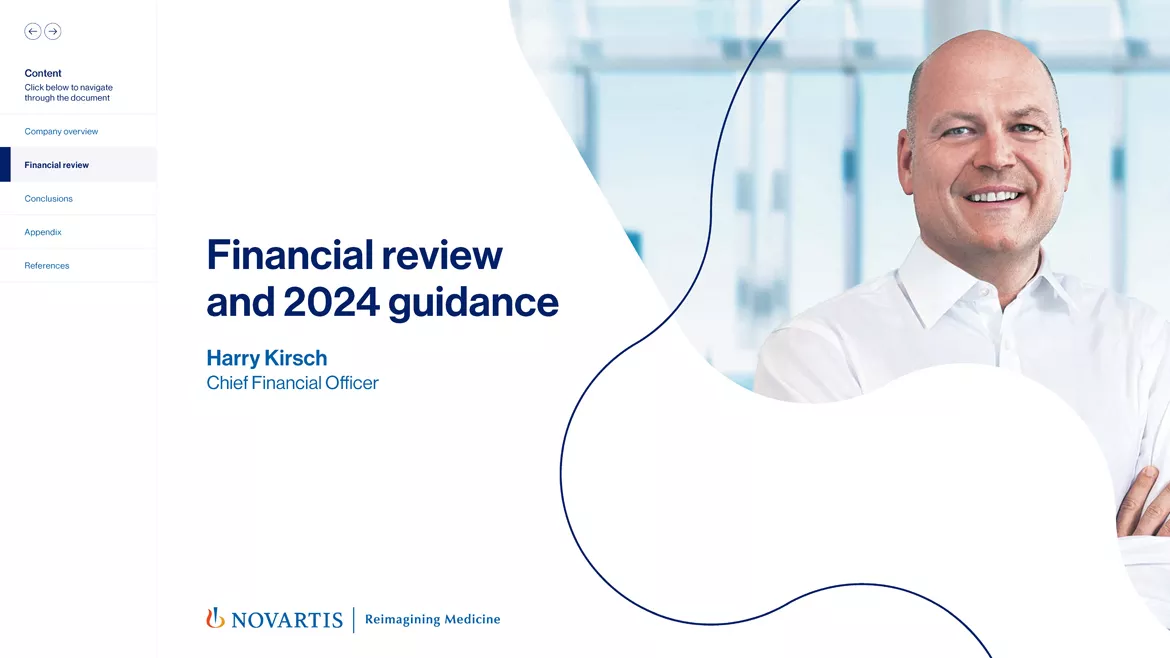
Yes. Thank you very much, Vas. Good morning and good afternoon, everybody. I'm now going to walk you through some of the financials for the fourth quarter and full year as well as provide you with our 2024 guidance. As always, my comments refer to growth rates in constant currencies, unless I would otherwise note that. Also throughout the presentation, I'm only going to talk about continuing operations. And just as a reminder, that continuing operations include retained business activities of Novartis, comprising of our Innovative Medicines business and the continued corporate activities. Discontinued operations include Sandoz and selected portions of corporate activities attributable to the Sandoz business as well as certain expenses related to the spinoff.
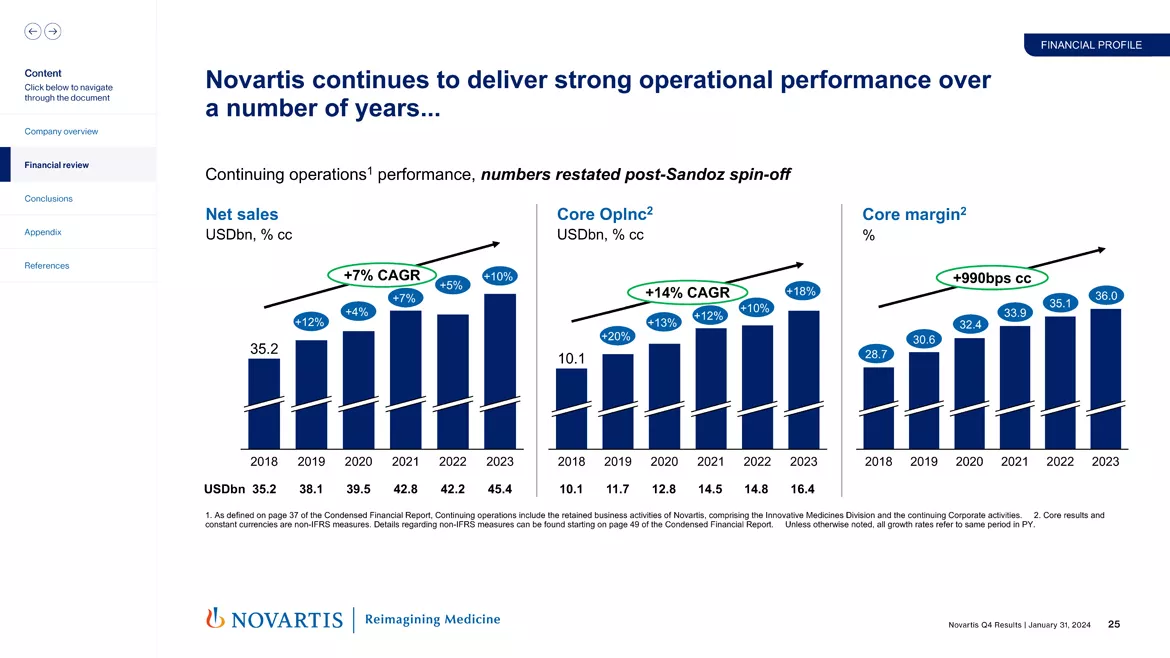
Next slide, please. This chart shows you the restated comparable numbers post the Sandoz spinoff. I know history doesn't tell the future, but track record is important. And as you can see, since 2018, top line sales growth has been 7% in average; bottom line, even 14% CAGR, and this has resulted in a core margin increase of 990 basis points in constant currency to 36%. So a very clear path also from a margin standpoint to our 40% in 2027. This strong performance has continued in '23, where we met or even slightly exceeded our upgraded full year guidance.
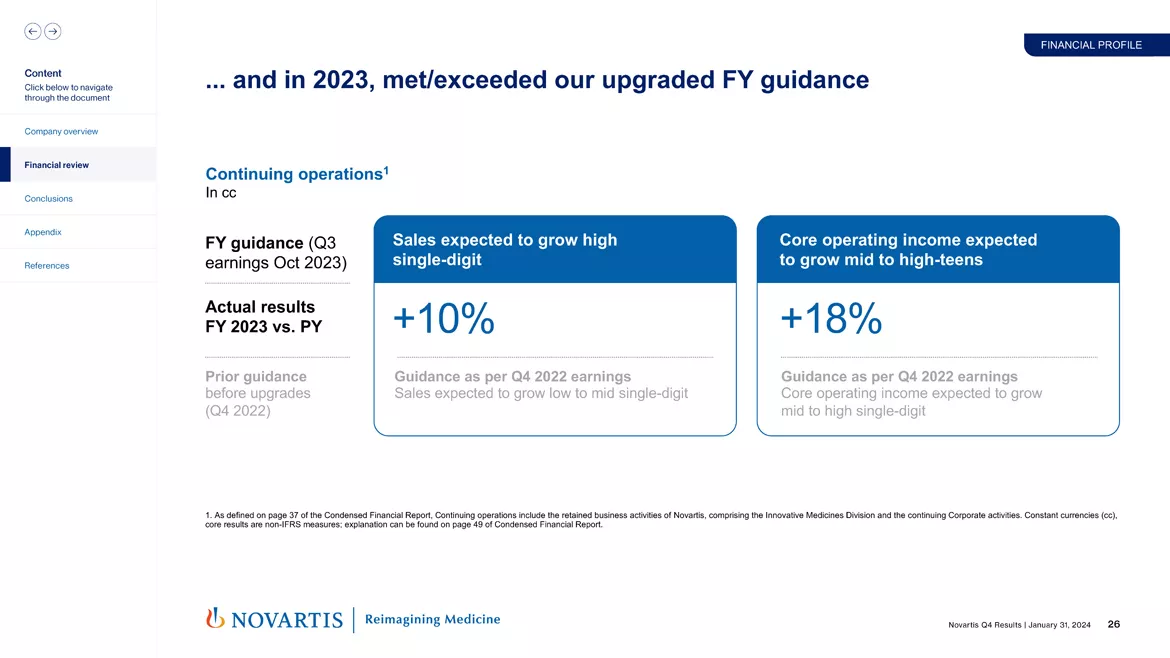
On the next slide, yes, just a little comparison here. On the '23 shows the top line growth of 10%. We guided to grow basically high single digits, last one, but we upgraded 3 times through the year and we started with a low to mid-single digit, really a testimony to the excellent business momentum that even strengthened throughout the year. And then core operating income at 18% and again, here, we were able to upgrade 3 times and could even slightly exceed the guidance we gave in October of mid- to high teens.
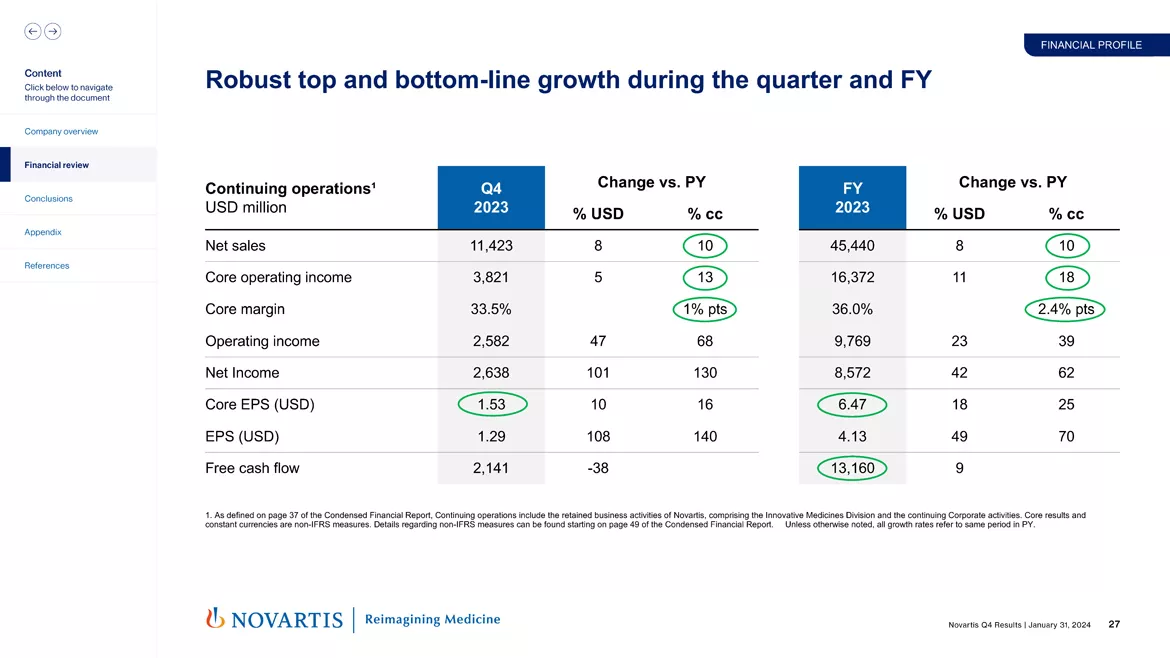
On Slide 27, a bit more detail about the 2023 performance, which I will go through by quarter and full year. In the quarter, top line growth was 10%. Core operating income grew 13%. As outlooked in October, quarter 4 of '22 was very high profit quarter to be compared to given that we were in the middle of our restructuring then, and that's why we guided the full year to where we were already assuming that quarter 4 bottom line growth would be a little bit less than the 9-month bottom line growth. But still, resulting in a margin improvement of 1 percentage point and core EPS at USD 1.53, and so a good quarter.
For full year, top line grew 10% and for core operating income, we delivered 18%, leading to a 2.4 percentage points margin increase. Core EPS was USD 6.47. And the full year cash flow was even more than USD 13 billion, another significant growth also on the cash flow side. As outlooked, therefore, we were over our guidance and strong full year results with also a strong quarter in absolute but of course, comparable base was a bit higher.
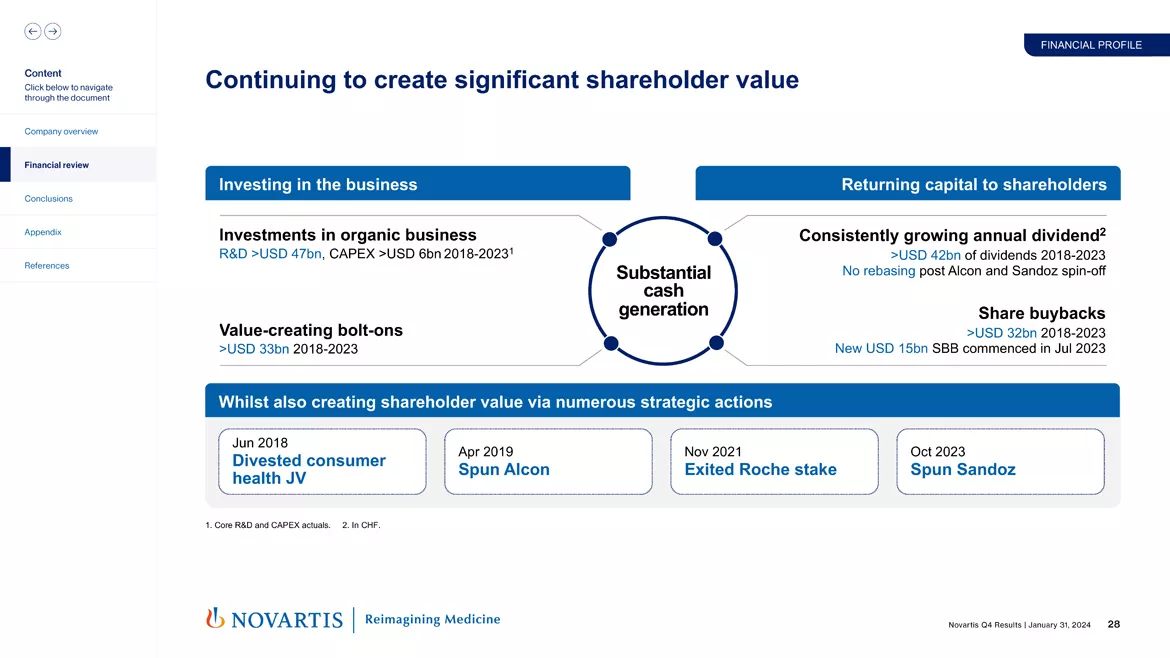
Now Slide 28. So we're continuing to create significant and sustainable shareholder value. As you know, we are a highly cash-generative business, and our strong cash flow allows us to optimize both investing in the business as well as returning capital to shareholders. In terms of investing in the business, of course, R&D is the key focus, in addition to launch and prelaunch investments. And from a business development, M&A perspective, it is value-creative bolt-ons in our core therapeutic areas.
In terms of returning capital to our shareholders, the focus has been on a consistent growing annual dividend in Swiss francs which has not been rebased post the Alcon nor the Sandoz spin-off. And with regards to share buybacks, we continue, of course, our most recent share buyback of up to USD 15 billion announced in July 2023 with up to USD 12.7 billion to be executed still by the end of 2025. Now we got some questions as we paused share buyback for a few weeks in January as we had to adjust our trading plan. Just to ensure everybody is clear, we will restart during the next days and it's our full intention to complete that share buyback as mentioned by the end of 2025.
Besides all of that, we have, of course, also created shareholder value through numerous strategic actions like divesting the consumer healthcare joint venture stake, spinning off Alcon, and divesting the Roche stake at CHF 356 and of course, importantly, and most recently, the successful completion of the spin-off of Sandoz on October 4 last year.
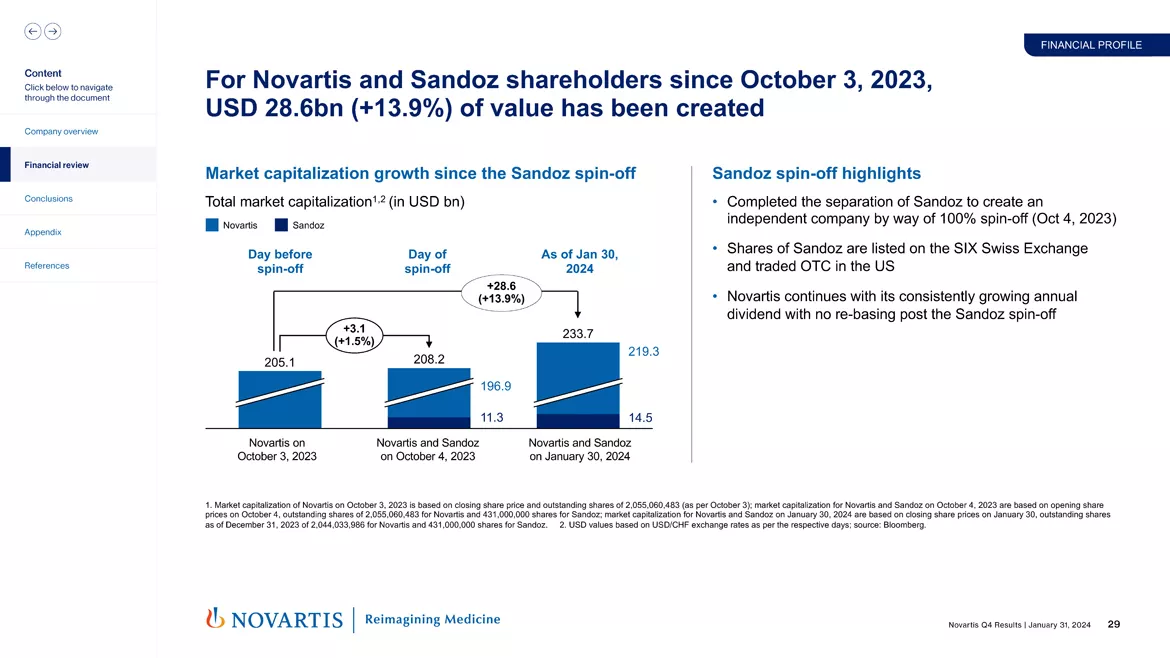
If we go to the next slide, please. Now talking about the successful spin-off of Sandoz. On the day of the spin-off, subsequently, both Novartis as well as Sandoz share price and the implied market capitalization have increased quite significantly. Since the day of the spin off, October 4 until yesterday, just to have the exact numbers from last night's closing, Novartis market cap has increased by over 11% and Sandoz over 28%. So in total, as a result of the spin-off and of course, subsequent market movements, a combined value of over USD 28 billion has been created for shareholders, continuing to hold Novartis and Sandoz share. Again, as a reminder, we are not rebasing our dividend post the Sandoz spin.
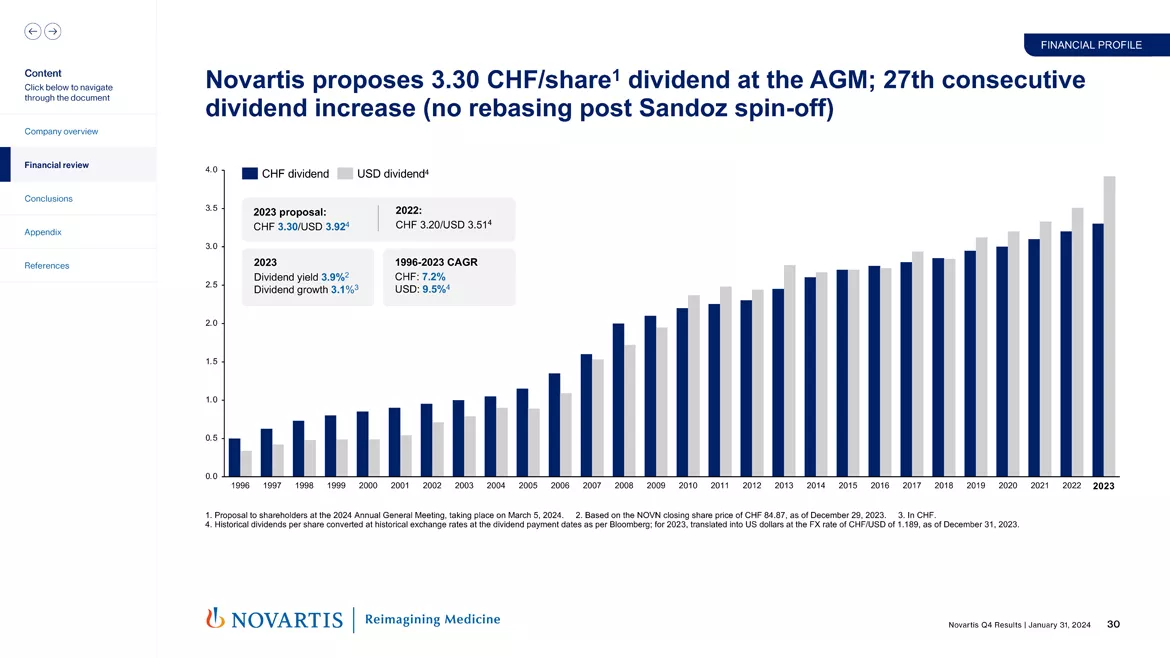
Speaking of the dividend, let's go to the next page. Yes, we are pleased to propose the 27th consecutive dividend increase to CHF 3.30 per share and US dollars even USD 3.92, and this is based on the CHF 3.20 last year. So an increase of 3% in Swiss francs and 12% in US dollars with a dividend yield reaching close to 4%. And it's fully in line with our policy of increasing our dividend every year in Swiss francs per share without rebasing post-Sandoz spin.
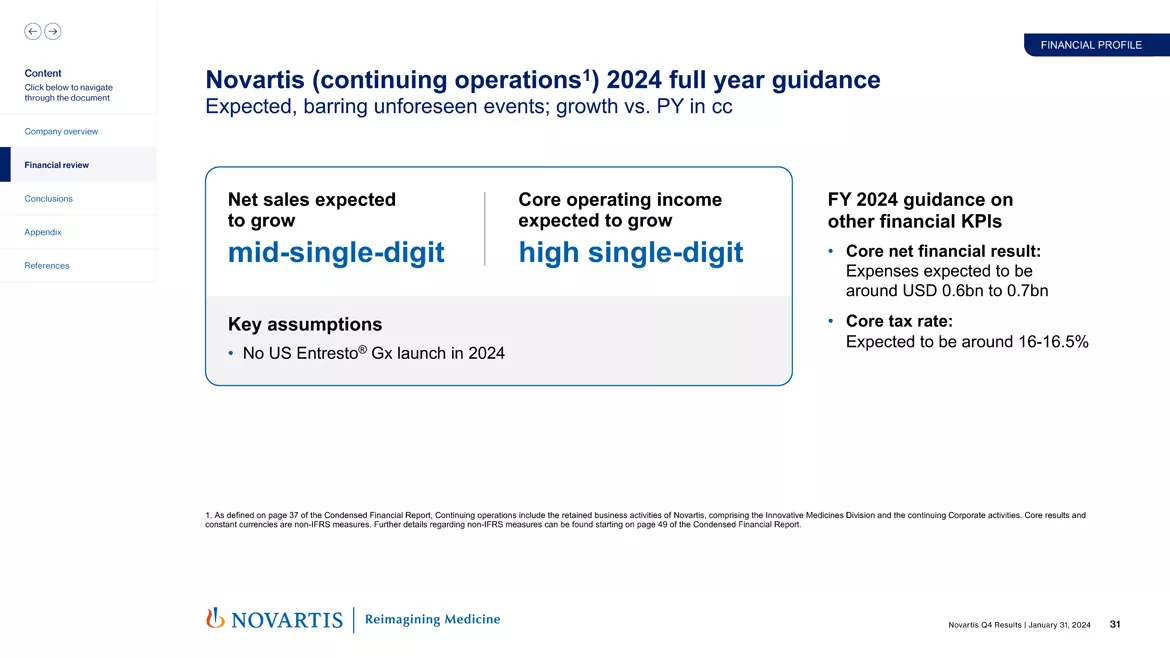
Now moving to 2024. Our full year guidance is for sales to grow mid-single digit and core operating income to grow high single digit. In terms of the drivers of Core OpInc for 2024, pushes and pulls are similar to 2023, and we fully expect our positive business momentum to continue. However, this prudent guidance assumes that there will be a higher generic impact in 2024 versus 2023. I'm sure we will discuss this later on in the Q&A.
For forecasting purposes, we assume no US Entresto generic entry in 2024. And to complete our full year 2024 guidance, please note that we expect core net financial expenses to be around USD 0.6 billion to USD 0.7 billion and the core tax rate to be around 16% to 16.5%.
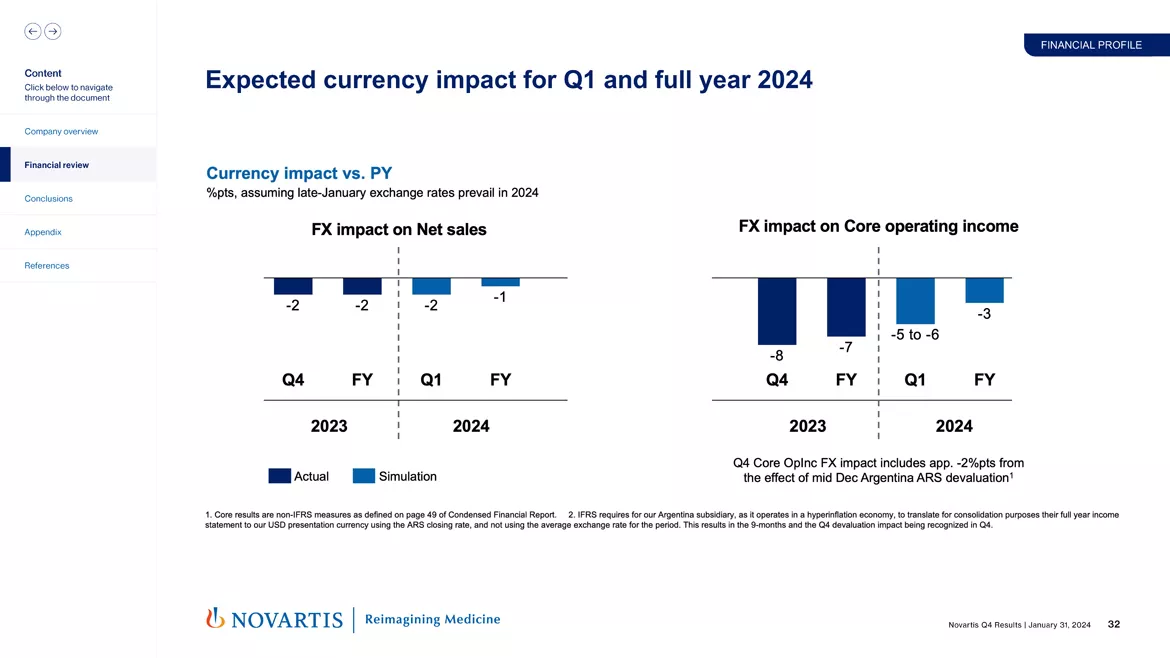
Now on to my final slide. There we go. Currencies, yes. So we have outlined some details regarding the currency impact. And as you can see, currencies had a negative 2 points impact on net sales in both quarter 4 and the full year as well as negative 8 points impact on core operating income for the quarter 4 and negative 7 points for the full year, driven by the strong Swiss franc.
There was a special effect on Core OpInc in quarter 4 by about 2 points due to the mid-December Argentina devaluation and then we have to catch up basically to hyperinflation accounting instructions, IFRS guidelines, the full effect in quarter 4. So it's 2 points worsening due to Argentina in quarter 4.
If late January rates prevail for 2024, we expect a full year impact of currencies to be less than '23, and on top line would be a negative 1%, and on the bottom line would be a negative 3 percentage points currency impact. And as a reminder, we do update this every month on our website as it is hard to forecast from the outside, but you get a monthly update on it. And with that, I hand back to Vas.
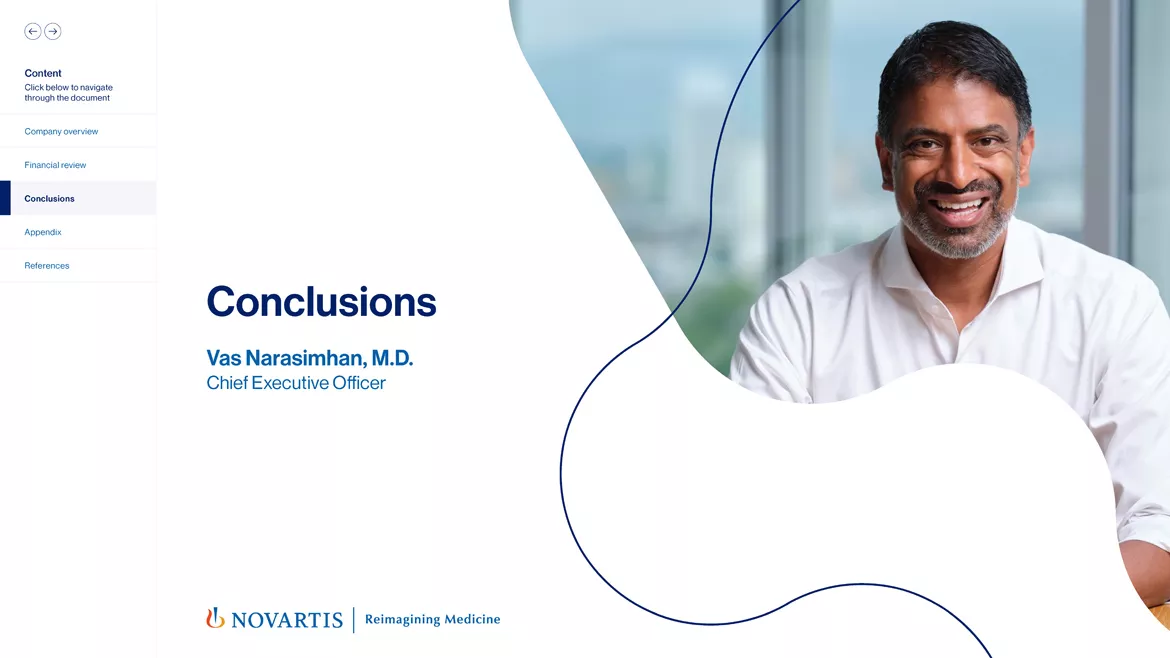
Great. Thank you, Harry.
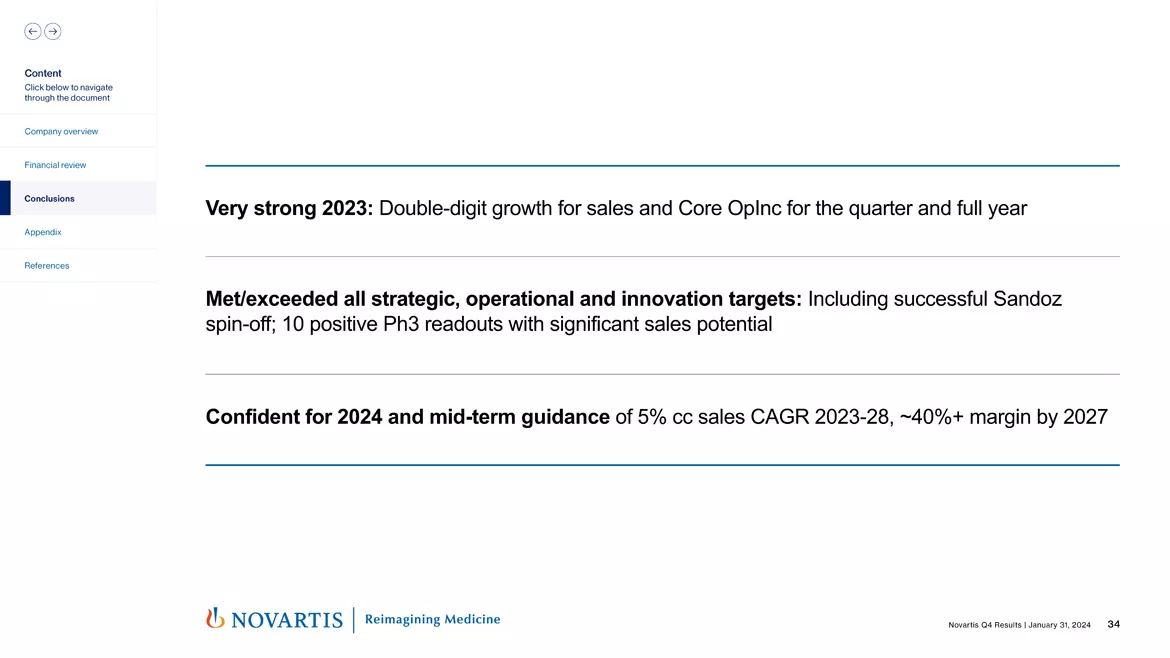
So in conclusion, if we go to Slide 34, we had a very strong 2023, multiple guidance increases, double-digit growth for sales and Core OpInc. I think really reflecting that our focused strategy as a pure-play innovative medicines company is the right one and really delivering strong operational performance. We met or exceeded our strategic operational and innovation targets, including the successful Sandoz spin-off, 10 positive Phase III readouts, all with significant sales potential.
And we're confident for 2024 and in the midterm, where we now guide to 5% constant currency sales, '23 to '28 and a 40%-plus margin in 2027, all building, of course, on the longer-term goal to maintain that mid-single-digit sales growth '28 and beyond.
So with that, we can open the line for questions. As the operator mentioned, we'll limit to one question for analysts, and then we'll come back through the list again. Thank you very much.
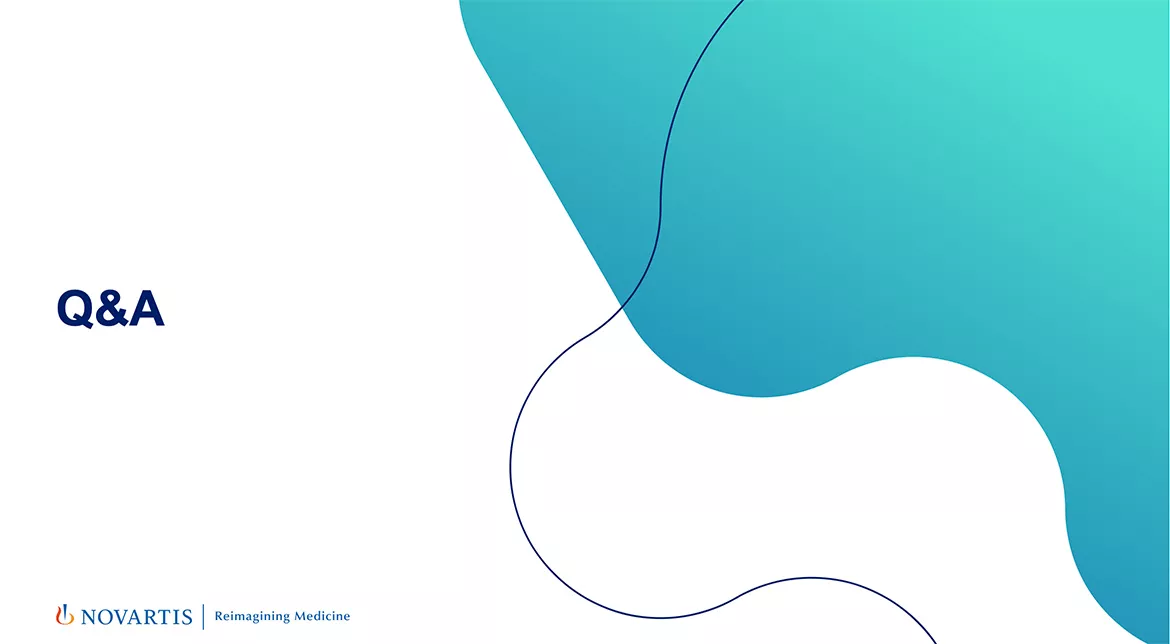
(Operator Instructions) We will now go to our first question. And your first question comes from the line of Matthew Weston, UBS.
Q. It's Matt Weston from UBS. My one question is around the growth in SG&A that we saw in 4Q and what it means for 2024 guidance. So there was a significant step-up in commercial spending. Vas, you mentioned in your opening remarks that you felt that 2024 guidance was prudent. Is the 4Q step-up bringing forward or front-loading launch spend given the exciting opportunities you have in '24? Or is that level a good indicator of the cost acceleration we should expect for the full year? Any help gratefully received.
A. Thanks, Matthew. And I'll hand it over to Harry. Harry?
A. Hello, Matthew. Good to have you around. I think quarter 4 came exactly in as we forecasted for the year and outlined our full year guidance in October. So I think we have to keep this a bit in perspective and not overreact to short-term consensus thinking. Because in the end, we increased our function costs in the full year like 3% in constant currencies with a growth of 10% on the top line.
I tried to explain, maybe I was not very successful in October, that quarter 4 of '22 was a very low spend quarter because we're in the middle of a big restructuring. Now quarter 4 spend is as usual seasonality of higher spend levels versus the first 3 quarters. In '22, that was a bit muted. We are back to that normal pattern. So you should have no worries about our cost development for '24. Our guidance of continued margin improvement is absolutely by the bulletproof because of our top line growth as well as our productivity programs and everything in '23 came in as planned.
Your next question comes from the line of Andrew Baum from Citi.
Q. I'm not sure if Dave is on the call, but someone might like to take this question relating to your cardiovascular outcome trials. I've previously asked about why not unblind the ORION-4, particularly given the pressures from the IRA in the 9 years prior to price negotiation.
I'd ask the same question about Horizon. These are very high-risk secondary prevention patients. We know that it's highly atherogenic particle. And again, you've got the same issue for 9 years. So is there any possibility of either of these trials being unblinded before the publicly stated dates? And maybe you could also opine on whether the bipartisan assets to try and reclassify advanced therapies for 13 years rather than 9-year exclusivity is going to start to move. It's obviously very relevant to you given Leqvio®, pelacarsen, Pluvicto®, etc.?
A. Yes. Thank you, Andrew. So right now, there's no plans to adjust our thought process on waiting for these studies to run the completion. I think as Dave outlined in the R&D Day, we continue to believe by having a longer follow-up, we're more likely to deliver very differentiated cardiovascular risk reduction in ORION-4. And I think with respect to Horizon, our powering calculations and the approach that we've taken, both with very high-risk Lp(a) patients as well as the kind of medium risk patients requires us to follow these patients out through 2025.
That said, we're very cognizant of your point, and we do debate and discuss them, especially in light of the IRA. I think a few things we're doing. First, on the policy front, there is bipartisan support for an amendment on, I think the 9 to 13 on so-called genetically targeted therapies. However, I think it will still be some time and likely not during this year, given it's an election year for that to really move forward. But we're hopeful that we can progress that over the coming years to enable that to move to 9 to 13, along with our broader policy goal as the industry to move 9 to 13 across all small molecules.
We also continue to invest in life cycle management for our entire siRNA portfolio. We struck at least a few deals now that really target annual dosing for siRNAs, most recently with a company called [Argo] Therapeutics. And there, we have multiple targets now that we're pursuing to try to move to annual dosing and/or combinations with other targets that would allow us to life cycle manage in the event that we need to ahead of that 9-year time frame.
So those are the approaches we're taking, but we obviously take your feedback seriously and we'll continue to evaluate accordingly. Next question, operator.
Your next question comes from the line of Florent Cespedes from Societe Generale.
Q. A quick one on your mid-term guidance. You have updated this guidance but now starting from a higher base from 2023. I was just wondering if there is anything new versus the last update last year. And if you see, let's say, new drivers that helped you to achieve this midterm guidance?
A. Yes. Thank you, Florent. I think a few things. So first, in terms of the growth drivers and what we overall saw in the quarter, in quarter 4 and on the full year, you see very dynamic growth for Kesimpta®, for Kisqali®. I think strong growth for Lutathera® and Scemblix®. And we also saw the return of, as I mentioned, strong demand signals for Pluvicto®. All of which gave us confidence in those brands outlook towards our peak sales guidance.
In addition, we have now the approval of iptacopan and the iptacopan positive or Fabhalta® positive data across PNH, C3G and IgAN, which gives us more conviction that this medicine will be a multibillion-dollar medicine as well. So that I think all was on the positive side from in-line brands. And then importantly, with the Scemblix® first-line data where we saw, I think, really – we believe will be potentially practice-changing data, this has an opportunity now as well to be a multibillion-dollar medicine.
So taking all of that together, that growth momentum for our in-line brands and strong pipeline performance gave us more conviction in that long-term guide. I would also note, of course, Kisqali® now has also filed for medium and high-risk women with early breast cancer. So I think it all gives us positive signals and momentum to continue that 5% plus guidance up to '28.
Your next question comes from the line of Graham Parry, Bank of America.
Q. So it's on Pluvicto®. So the number in the quarter was a drop off quarter-on-quarter. I think you said in Q3 that you've actually seen about a 50% increase in patient starts. But also, there was an offsetting factor here of sicker patients not getting the sort of the last 2 doses. So can you just help us with the dynamics of why that increase in patients you saw in Q3 didn't translate into a higher sales number in Q4?
And then on sites, I think you'd said 300. So how many are you targeting for 2024 and given your supply unconstrained. Is this actually now the rate-limiting step to getting to the multibillion number that you've talked about for the VISION indication?
A. Yes. Thanks, Graham. So on Pluvicto® in quarter 4, we saw a steady rebuild, but I think we did not see yet the full replenishment of the base of patients, given that we still had supply constraints into the August or July-August time line. And so over the course of quarter 4, we saw more patients getting on therapy, which then, of course, gives us the 4 to 6 doses on those patients, which we build that base.
I would also say during the holiday period, we did see less as we were expecting. In the Christmas period and Thanksgiving period, these patients tend not to want to have the therapy given the radiation can lead to – does lead to a restriction on being around children and other loved ones. So I think those dynamics did play a role. But we did see growth in new patient starts in Q4 versus Q3. But the growth was not, I think, as strong as maybe what the external world predicted.
We had tried to guide in quarter 3 to the expectation that we would be to around USD 1 billion, which is exactly where we are at the USD 980 million mark, but perhaps we should have been more clear on our outlook and expectation. All of that said, we, of course, can track this on a daily basis, and we see strong growth in demand, strong overall dynamics, and we continue to expect to see robust quarter-on-quarter growth for Pluvicto® over the course of this year, getting us back towards that multibillion-dollar outlook that we've guided to in the VISION population.
Q. And centers?
A. And centers, sorry, Graham. Yes. So our goal is to get to 500 plus centers, and we're expanding now rapidly. I think centers are probably one constraint and then I think the other in terms of the growth. And so we expect to have the add centers at a steady clip over the course of this year. And then we also are encouraging physicians now that supply is unconstrained to treat earlier.
So therefore, the average number of patients moves more towards 6 doses per patient which will certainly be our goal over the course of the year. I think both of those dynamics will fuel growth for this brand over the course of 2024.
Your next question comes from the line of John Priestner from J.P. Morgan.
Q. So you said that the 2024 guidance includes the impact of generics, which we assume is for kind of Promacta® and also Tasigna®. So what you're thinking behind the actual timings of those generic entries? And Also, you also said that the 2024 guidance could be somewhat prudent. So what are some of the key kind of levers that you could execute on to kind of exceed that guidance?
A. Yes. Thanks, John. So there are 3 generic entries we would expect over the course of the year, but we're not in a position, I think, to provide specific guidance on when these entries would happen given the, I think, unpredictability, both in terms of our own goals to defend our IP as well as supply for some of these parties.
The 3 would be Promacta® and Tasigna®, as you noted, as well as Sandostatin® LAR where there is no approved generic but no product in the market. We, of course, would provide updates when these would enter over the course of this year. But I think we – this is our current forecast, and we'll see, of course, how things evolve. Now in terms of our full year performance, Harry, in terms of the prudent guidance?
A. Yes, John, thank you very much. I mean we will not say. When we assume, it is also financial forecast assumptions. Of course, we do appropriately defend our IP when possible. Of course, on Sandostatin® LAR, there is no IP anymore. That's more about the ability of the generic producer to produce. It's a very-difficult-to-produce product.
On the other hand, we have barely distributed these 3 potential entries for forecast purposes over the quarters. There's a bit of a generic portfolio play, if you will, and now if all of them will come a bit later, then we may have an upside to our guidance. So that's what we meant with that. And of course, overall, we do assume that our key growth drivers continue to perform very well. But it's a bit difficult with these 3 different generics to make assumptions.
And so we do them in a prudent way. And there could be changes to this if either one competitor cannot produce or we have some upside on the LOE and patent defense, if you will, on the other 2.
Your next question comes from the line of Tim Anderson, Wolfe Research.
Q. Thank you. On Cosentyx®, a question on pricing and market access dynamics in '24, just in the US with multisource biosimilar Humira on the market, now albeit only for 6 to 7 months. Are you seeing any access tightening in '24 such as more step edits given indication overlap? And if not in '24, then do you think it might tighten in 2025? And then also on this topic of just the level of US net price erosion in '24 relative to what it was last year?
A. Yes. Thanks, Tim. In terms of Cosentyx®, we actually feel pretty good about overall the access environment for 2024. We've had modest gross-to-net shifts overall for the brand, and we have a broader access in some of the major accounts versus what we had in the past. So we haven't seen any, let's call it, increased impact from biosimilar adalimumab.
We think this is mostly because we are contracting within the IL-17A class. And given our track record in the class and large position that's enabling us to manage the overall access environment successfully, have not seen to my knowledge, any increase in step edits either with respect to Cosentyx® access. Now I think looking forward, obviously, always difficult to predict.
I think some of the tailwinds we have going for us is the new indications in hidradenitis, which, of course, at least for now, we're only one of few medicines that have that indication, which gives us strength in terms of formulary negotiations. Hopefully, some of the other indications come through as well. Separate from that as well as with Cosentyx®, we've launched in the IV setting as well, and that's also another, I think, important growth driver for this medicine over the coming years.
So overall, I think a pretty stable position for Cosentyx®, at least for 2024 and of course, as we understand better '25 and beyond, we'll keep everybody updated.
Your next question comes from the line of Simon Baker, Redburn.
Q. And it's another one on Cosentyx®. I wonder if you could give us your thoughts on the expectation of the uptake for Cosentyx® in HS. I've had some clients suggesting it's slower than expected given the quality of the profile and the paucity of the competition that you suffered. How do you see the potential and the uptake there over the course of the next year or so?
A. Yes. Thanks, Simon. I think it's early days. So I think I don't want to, I think, get too far ahead. But so far, we've heard positive feedback overall from clinicians. I mean, Cosentyx® has an outstanding long-term safety profile. I think that's been well established now over many, many years, doesn't have some of the safety topics that some of our competitors may have.
And so I think that allows us to have a very strong comfort level with dermatologists for treating these patients. And as well, overall, the efficacy, I think, is solid with the opportunity to give these patients a safe, efficacious option. And as you know, the big challenge in HS is really getting patients to come in to be treated given that it's been so long since there have been new medicines that have been launched since the TNFs were indicated for this condition.
So I think solid early start, and we'll certainly see how the quarters unfold, but I think the safety profile and the overall comfort level in dermatologists gives us a very good position for this launch.
Your next question comes from the line of Kerry Holford from Berenberg.
Q. A couple of questions for me, please. Firstly, Kisqali®. When do you expect that drug to become eligible for price negotiation under IRA? And given we're moving towards heading up an expiry 2031, can you talk to the life cycle management options available to you here. When I look at the Novartis pipeline, I see a few breast cancer specific assets, but perhaps I'm wrong. And any feedback you could give there, any areas of interest would be greatly received.
And then business development. Clearly, you've been somewhat busy over the last 12 months. What's your appetite for deals moving into 2024, size, therapeutic category, is RLT still an area of focus for M&A, business development. Many thanks.
A. Thanks, Kerry. So first on Kisqali®, as you know, it's not a precise science to predict IRA for these patients. I'd also note in the early breast cancer population, these patients are younger and tend not to be in the Medicare population. So I'd say we really see this being a topic for Kisqali® towards the end of the decade, but importantly, it would only affect the portion of our sales that are in the Medicare population.
And we'll, of course, as we learn more and understand better how the program will unfold, we'll keep you all updated. But we think we have a very good runway now for this medicine for the coming years, both in metastatic and assuming approval in the early breast cancer space.
In terms of life cycle management in breast cancer, of course, the one opportunity is other CDK targets, which we are pursuing in-house, and that's something that we are looking at within our research labs as well as potential for combinations, and that's another topic for us as well. We also continue to advance early stage programs with RLTs in breast cancer as well, not specifically, life cycle management. Kisqali® would give us the opportunity to bring forward radioligand therapies in the breast cancer space and that's an area of high focus for us at the moment.
So I think a combination of novel targets in small molecules as well as radioligand therapies in the breast cancer – overall in the breast cancer space. So in terms of business development, as outlined in the slide, our strategy is very much to focus on our 4 core therapeutic areas and our 3 key technology platforms. So those technology platforms are cell therapy/immune reset, cell and gene therapies/immune reset, RLT and RNA therapeutics, and I think that's well known.
And in terms of size of deal, no change to our overall approach of smaller than USD 5 billion bolt-on acquisitions, but the vast majority of those deals being sub-USD 1 billion deals and no change to our approach there from what we've previously stated. So moving next.
Your next question comes from the line of Seamus Fernandez from Guggenheim Securities.
Q. So just wanted to ask one particular question in terms of the sort of business development strategy. I know, Vas, you've already talked about this, but I wanted to get a little bit more clarity on specifics around the sort of threshold that you've talked about publicly. Is that sort of USD 5 billion and below threshold really still kind of the target range? Or given the success that you are seeing in some of the other areas of development, is there the opportunity to potentially go larger in terms of the potential transactions?
Just wanted to get a better sense of if you feel there's more flexibility given the Phase III – solid Phase III hit rate that you've had or if you're kind of sticking to your guns or to your knitting in the USD 5 billion and south range?
A. Yes. Thanks, Seamus. So really nothing, I think, to add beyond what I've already stated. I mean we, of course, look at the full range, as you would expect a company of our size, a full range of potential opportunities within business development. But what we consistently see is the opportunities we have, where there is the most significant opportunity for value creation as well as a differentiated view versus the market, is on the lower end of the range of deal values.
I think that's why when you look at the 15-plus deals that we did last year, vast majority are under USD 1 billion or even under USD 500 million. We did Chinook at USD 3.1 billion. And I think that's where we see the best opportunities for us as a company. I will never exclude that we would do anything if it makes sense for our shareholders and makes sense for the long-term profile of Novartis. But our focus is very much on that bolt-on sub-USD 5 billion, sub-USD 2 billion, sub-USD 1 billion range programs, and that's where I think we'll be.
Your next question comes from the line of Emily Field, Barclays.
Q. Just a question on remibrutinib, how far along are you in the recruitment of the MS trials, just given we've seen another partial clinical hold in the space? And then if you could just remind us how your molecule is differentiated given the – we did see that Phase III failure after your R&D day?
A. Yes. Thanks, Emily. So on remibrutinib, let me start with why we think our molecule is differentiated. When you look at the structures and if you go back to some of our slides in R&D Day, you'll see that our molecule as a different overall chemo type structure than some of the other peers, we believe that the liver signals that have been seen thus far in this group of medicines has to do with off-target toxicities related to the structure of the molecule.
So we have a highly potent BTK inhibitor, a covalent BTK inhibitor that we think is unique and it's at least so far in the clinical and preclinical work profile in terms of having any of those off-target toxicities. So we, of course, already have read out 2 positive Phase III studies in CSU and plan to file with the 52-week data in the second half of this year. We continue to pursue as well remibrutinib in other immunology indications where we think there is an opportunity given it's a safe profile. And importantly, at that dose range, 25 milligrams BID, we saw no liver signals in those dermatology studies.
In terms of the MS trials, we continue to recruit on track. However, we don't expect a filing before 2026, if I'm not mistaken. And we did have a futility analysis looking at futility for noninferiority to our comparator, and we passed that futility analysis. So the program will continue. So we don't see any safety signals. We've passed a futility analysis, which we put in place given some of the data that some of our peers have read out, and we'll continue then to progress the study in multiple sclerosis as well.
We do believe remibrutinib has the opportunity to be a significant medicine across a range of indications, particularly as the safety profile continues to hold up because of the structure of the medicine.
Your next question comes from the line of Peter Welford from Jefferies.
Q. Just curious, I would come back to Fabhalta® or iptacopan. You sort of had some more cautious commentary perhaps than you might expect it for a new launch. I wonder if you could just talk a little bit about does this, as you say, relate very specifically to the PNH market and perhaps why you now have more confidence that you potentially can't get into some of those currently untreated patients sooner?
Or does it reflect the REMS and the initial program and perhaps impediments you're seeing getting this in front of doctors and through the process than perhaps you envisaged? And I guess, how does that and the profile of the drug, if at all, read into the potential rollout for the larger IgAN indication potentially in the future?
A. Yes. Thanks, Peter. So first on PNH, it very much – the uptake very much has to do with the REMS as well as some of the other elements that need to be placed. So particularly vaccinations. And so this takes time to put in place for this medicine as well as our organization getting the infrastructure fully up and running.
We estimate 7,000 to 8,000 patients with PNH in the United States, roughly 3,000 to 4,000 of them being treated as today. And so in such an ultra-rare patient population as well, you have a relatively high dispersion of physicians who are treating 1 or 2 patients. It also takes time to reach all of these physicians.
It doesn't change our long-term belief that this is – can become the medicine of choice for these patients given it's a twice-a-day safe oral medicine with high efficacy and I think a reasonable safety profile overall. And that will just take time as we get physicians up to speed, either patients in the position where they need to switch because they're uncontrolled, over time, even controlled patients, we would argue would want to be switched and then new starts as well.
And then we do make efforts already to try to reach that half of the – estimated half of the patient population, which is currently untreated. So we just want to set reasonable expectations for the first year, but then we hope to ramp up thereafter.
We do think that given our positioning in C3G and IgAN – C3G, already also being an ultra-rare disease; IgAN, we target refractory patients. Again, given that we're targeting a very select patient population, we think we can absolutely manage the patient start process for those patients and then ensure a very strong uptake for the medicine.
And then if you look at the future indications for Fabhalta®, largely also in the ultra-rare space, which will then – I think as we build that capability, we should be able to get patients on therapy sustainably over time.
Your next question comes from the line of Richard Parkes from BNP Paribas.
Q. It's just following up on business development strategy. I mean it's been quite clear the last 18 months, you're now very confident about growth through upcoming LOEs for the business overall, but you still will have to absorb LOEs in specific therapeutic categories and also be thinking about Entresto.
So when you look at your cardiovascular franchise, given the Leqvio® uptake, maybe, they've been a bit slower and the supposed clinical risk, are you confident you've got enough coming through recently maintaining a healthy franchise portfolio that had not had any kind of negative leverage? Or is that an area where you would look to maybe be more active in terms of business development to bring in later-stage products?
A. Yes. Thanks, Richard. We feel very confident with what we have in-house in cardiovascular disease. When you look at it, we have Leqvio® in secondary prevention and then moving to primary prevention as well. We have pelacarsen of the Lp(a) program. We have a program called XXB, which we are currently moving forward in mid-stage studies in hypertension and heart failure as well as an oral version of XXB, as well NPR1 agonist that we're also bringing forward.
And as I've noted, we have an extensive in-house siRNA effort targeting a range of lipid lowering and cardiovascular targets as well as external collaborations that we've also now brought on board, which we think allows us to cover most of the key targets, which would be of interest for siRNAs. And our goal is: one, to move to new targets; two, to move to combinations; and three, also to get to annual dosing, which we think is the right strategy in cardiovascular disease in the long run.
Of course, other companies are pursuing orals. I fully understand that. But we believe that in this space, given the compliance challenge over the long run that's been demonstrated over decades, having infrequently administered siRNAs on validated targets is the right strategy. So given all of that and the efforts that we have ongoing, we feel very comfortable with our internal cardiovascular portfolio and pipeline. Next question, operator?
A. (Operator Instructions) Your next question comes from the line of Mark Purcell from Morgan Stanley.
Q. On Kesimpta®, Vas, hopefully you can help us understand the growth dynamics here and what NBRx leadership means, especially in light of the ex-US acceleration. So when you think about B-cell NBRx share, how does the ex-US share compared to the US where we get data from Roche?
And then when I look to the NBRx leadership footnote in 7 out of 10 markets, it just data on file. So could you help us understand, I guess, where infusions are more of a barrier to treatment in some ex-US markets versus US, where your share stands relative to the alternative infused therapy in this space? And then just a housekeeping on Kisqali® and the NATALEE filing, did you include no negative patients in that filing?
A. Yes. Thanks, Mark. So Kisqali®, yes, no negative patients were included. On Kesimpta®, so first on the ex-US dynamics, I think, first, it's important to note, outside of the US, you don't have the same structure as Part B for providing an infused medicine. And in many of these healthcare systems, there's a preference to move patients out of the medical centers and medical homes and more having at-home therapies.
So in those key markets, we really see a dynamic. I don't know that the specific shares off hand, but we see a dynamic where we are being a favored class of medicines in some of the large ex-US markets. We have very strong performance in markets like Germany, very strong performance in markets like Japan. And so I think that's really just a reflection of different dynamics in those markets where there's a preference for neurologists to provide patients a medicine that's easy for at-home use.
And we hope, over time, as we now move Kesimpta® more broadly across Europe and Asia, we have the opportunity to drive significant growth ex-US. In the US, there is different dynamics. Right now, we estimate that the B-cell class share of NBRx is in the mid-50% range, 55%. And over time, we expect that to continue to grow. Kesimpta® share within the B-cell class is in the high 20s, 27% to 30%, depending on when you look. And we right now are growing with the B-cell class overall.
But very much our goal over time is to grow our share of the B-cell class, and that's something we're very much focused on. That will take, I think, time for us to achieve, but that's going to be important if we want to get well beyond the USD 4 billion guidance we've already given. We think we can get to the USD 4 billion just by the march of the B-cell class. But if we want to do better, we need to improve our B-cell class share in the US, and that's something we're definitely focused on.
Your next question comes from the line of Stephen Scala from TD Cowen.
Q. I'm curious what happens with Entresto IRA price negotiation in 2026 when generics can launch in 2025? It would seem that if there were an Entresto generic, then Entresto would not be eligible for price negotiation. Is that how you see it? And has that come up in price negotiations so far? If yes, then the best case it would seem for Novartis would be limited generic competition, maybe even an authorized, which could turn out to be a plus for Entresto revenue?
A. Yes. Thanks, Steve. So it is a valid point. And our position would be if there is a generic that's launched that a medicine in our portfolio for the current guidance of the IRA would not be eligible at that point in time. So that would be our view. But I think, as you know, there's many things that are still unfolding with respect to the IRA negotiation.
I obviously can't comment on our approach to the various generic entrants and our approach on how to manage that. I would say that look, for Entresto, even beyond in the US, we guide to this 2025 – mid-2025 LOE. And IRA, if we were to move – not have a generic enter in 2025, we would be IRA eligible in early 2026. So one way or another, we are going to have Entresto being impacted in this period of time.
What is important to note is we guide to 5% plus for '23 to '28 growth even with Entresto coming out in the US and also coming out in Europe, given the time line of our RDP in Europe. So I think we feel confident we can grow well beyond the Entresto LOE or IRA. However, it ultimately happens in that period. Next question, operator?
Your next question comes from the line of Matthew Weston, UBS.
Q. It's a follow-up on Pluvicto®. Vas, I think it's JPMorgan and at the R&D Day, you highlighted PSMAfore filing in 2024. Now it's the second half of 2024. So can you give us an update, has anything changed? And also, can you just give us an update on your discussions with regulators? I know there's been a lot of discussion about the modeled control arm, given the significant crossover. Can you give investors comfort that you're still confident that it will be acceptable to FDA and regulators around the world?
A. Yes. Thanks, Matthew. So we don't have any updates. The trial, as you know, continues to accrue events. I mean based on our current estimates, we think the second half 2024 filing is the right timeline to provide at this point in time. But of course, this will evolve as the events accrue.
In terms of our confidence, nothing has changed. When you look at the overall data set that you saw last year, you saw very impressive gains in our PFS. You saw impressive gains in ORR. You saw a high quality of life improvement, a relatively clean safety profile even versus ARPI comparator arm. So I think a positive safety profile overall.
So we think we have a very compelling case. We think it's really a matter of getting to the higher resolution, both in terms of the adjusted analysis where we're already below a hazard ratio of 1, as well as a tighter radius around the all-comers analysis as well for the OS. And so this will be, of course, a topic of discussion with the FDA, but we think we can make a very clear and compelling case that this medicine should be offered to patients in the pre-taxane setting.
And then we also are continuing, as I mentioned, to move forward rapidly on PSMAddition as well as Pluvicto® in the oligometastatic setting, so we can cover all of our bases. I do think, overall, as an industry, we'll learn more with some of the upcoming ADCOMs on – from other competitor medicines on how the FDA is thinking about OS, crossover and how to manage this.
And I'm hopeful that overall patient benefit is what ultimately rules out over some of the statistical – pure statistical considerations given that we are encouraged to utilize crossover in our studies to be patient-friendly in an appropriate way. I think it's very important we start to be looking at the adjusted analysis. Otherwise, this puts, overall, the industry in a very challenging position.
Next question, operator?
Your next question comes from the line of Graham Parry, Bank of America.
Q. Just wanted to dig into some of the moving parts for the guide on generics, you sort of made some sort of high-level comments there. But in terms of the ability to manufacture, I assume that Sandostatin® LAR, I think have gotten approval, December. But is that a restriction a legal one? So is there any litigation around manufacturing, even if there isn't around the approval or is that a TechOps consideration there?
And then on Promacta®, I believe there's no litigation outstanding. You have a salt patent in 2026. So what are the moving parts for timing of the launch there? And is a 2025 or '26 launch on Promacta® even also still a possibility?
A. Yes. Thanks, Graham. On Sandostatin®, there is no litigation ongoing. I think – and I can't comment on other companies' manufacturing capabilities. I think what we did observe in Europe with the launch of generics is there was limited supply available for those launches given the complexity of the manufacturing, and we believe that that's a complexity as well that would still be the case in the US.
This is a very difficult medicine to consistently make and characterize and release. But obviously, that's for the approved generics to ultimately determine. So we'll be monitoring to see how and when that product comes to market and in what volumes.
And in the meantime as well, I mean, we very much are focused on our Lutathera® frontline data, where we, I think, presented really compelling data to make Lutathera®, the medicine – frontline medicine of choice.
It's already on label. We're already promoting that to physicians, making sure physicians understand the data set that we've now generated with the NETTER-2, so that gives us an opportunity as well to maintain our neuroendocrine tumor business.
With respect to Promacta®, not much more I can add. We, of course, continue to defend our IP, and we'll do so and try to maintain the medicines protection for as long as possible. But at this point in time, I can't provide any further details or guidance on Promacta®. For forecasting purposes, we're saying a generic entry in 2024. But as always, we defend our IP to the fullest extent possible. Moving to the last question, operator?
A. Your last question today comes from the line of Tim Anderson, Wolfe Research.
Q. Thank you so much. Obesity, I think you've been asked this before, but quite possibly the biggest therapeutic category. You guys have a big presence in cardiometabolic. How high of a priority is it to enter the space? There are acquirable assets in clinical development. They fall into that sub-USD 5 billion range. Why not move on one of them? Can't late entrant products still capture revenues or Novo/Lilly just too far ahead to justify the cost of a competitive development program?
A. Yes. Thanks, Tim. So look, when we think about the obesity market, we very much look at it in the lens of our presence in cardiovascular disease and wanting to ensure we have a presence that enables future cardiovascular drugs we have in our pipeline to either be combinable or available to patients with the full range of cardiovascular disease. So it's certainly something we're evaluating and looking at.
Our current view is that given the number of companies already pursuing injectable and oral GLP, GIP top assets that we should be focused on differentiated assets that have novel targets or novel approaches, novel profiles, which is what we look at in research. But of course, we evaluate all the opportunities that are currently out there, given the size of this market and the importance for cardiovascular health. So obviously, if we find something of interest, we'll pursue it. But at the moment, I can't really say anything specific about anything we're looking at.
Perfect. Thanks, everyone, for joining. We look forward to keeping you updated over the course of the year and wish everyone exciting 2024.
A. Thank you. This concludes today's conference call. Thank you for participating. You may now disconnect.